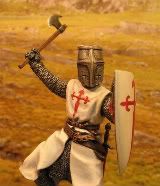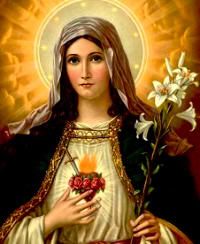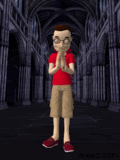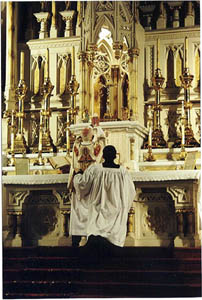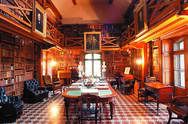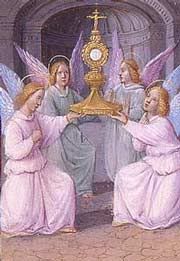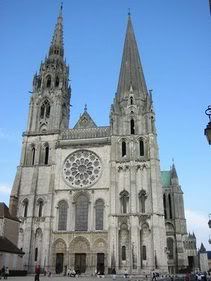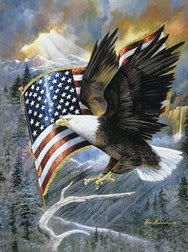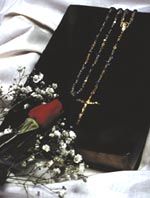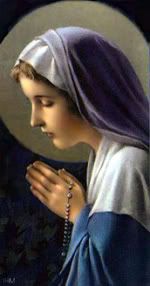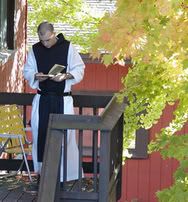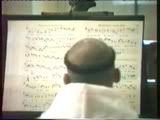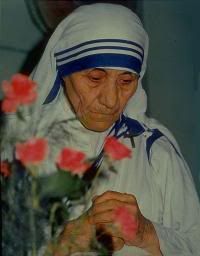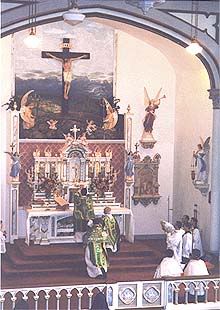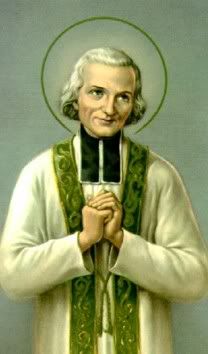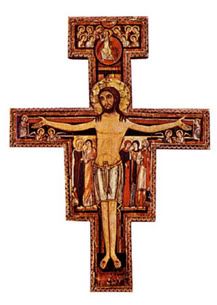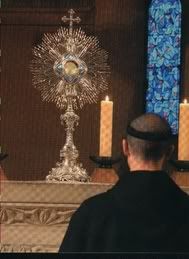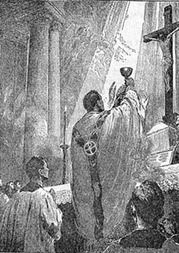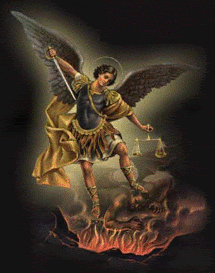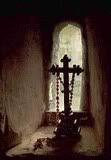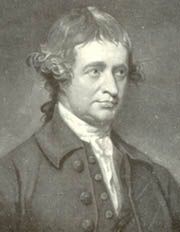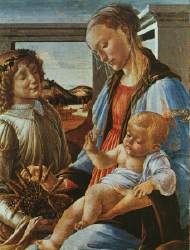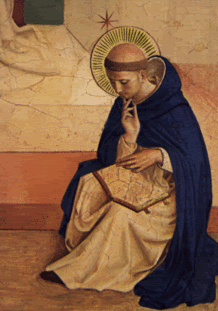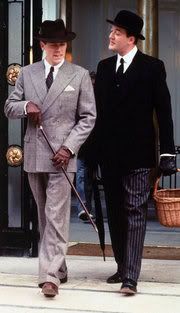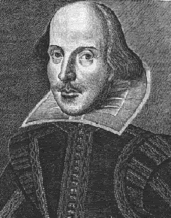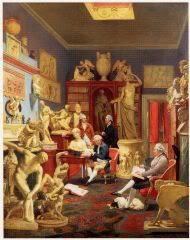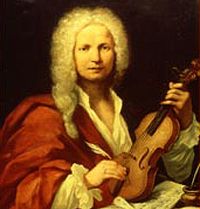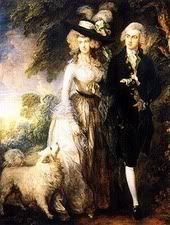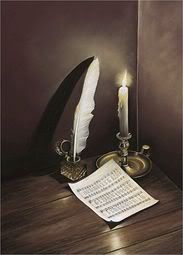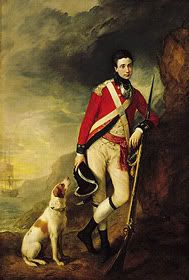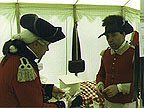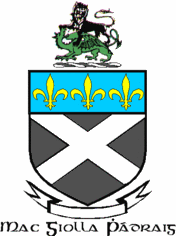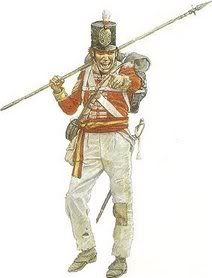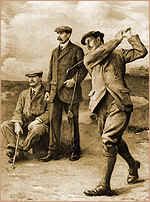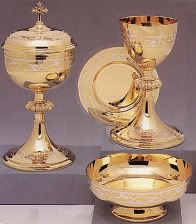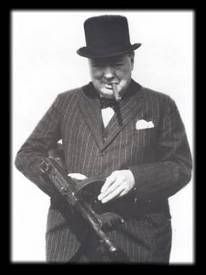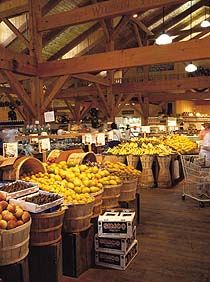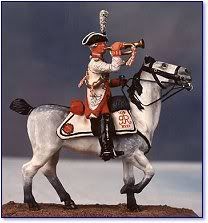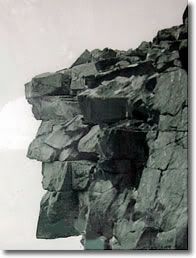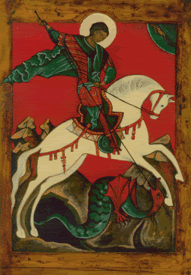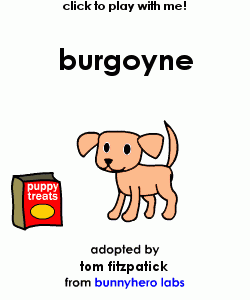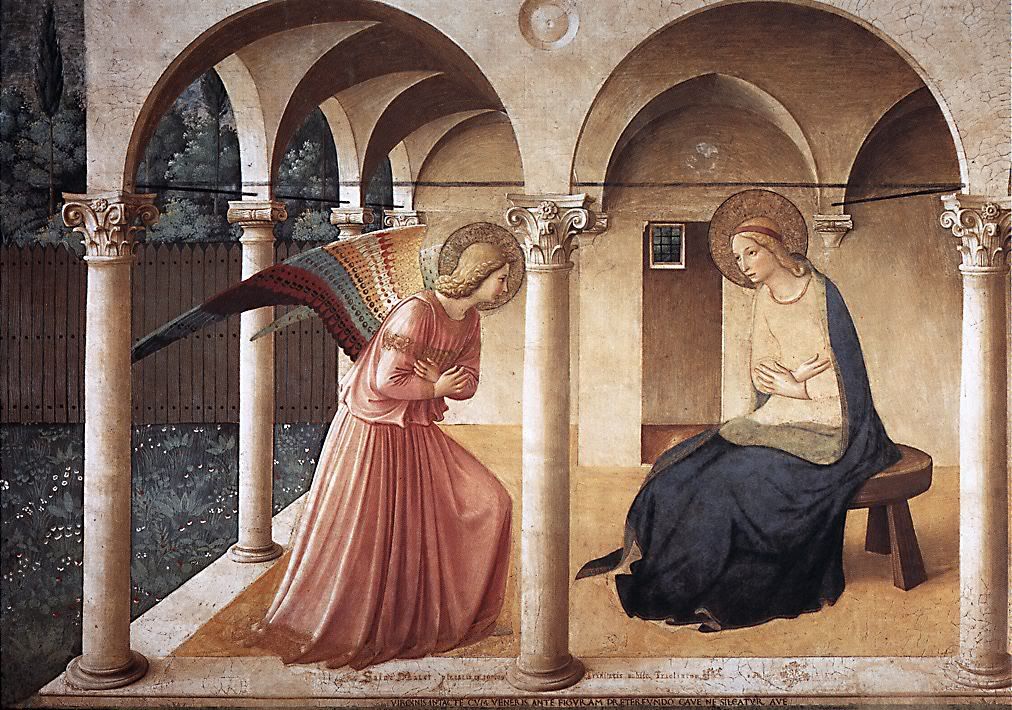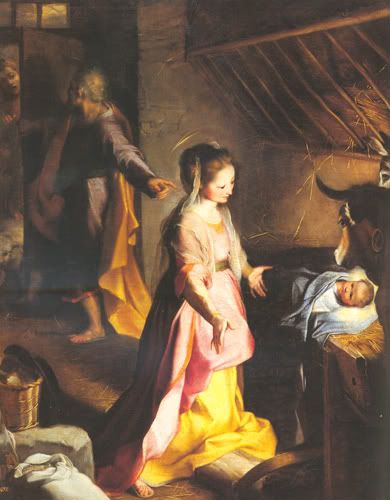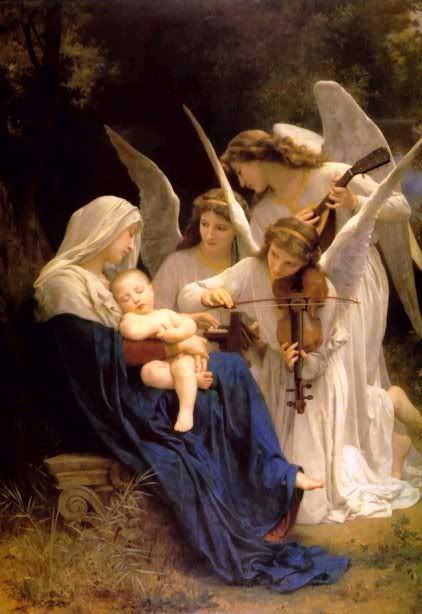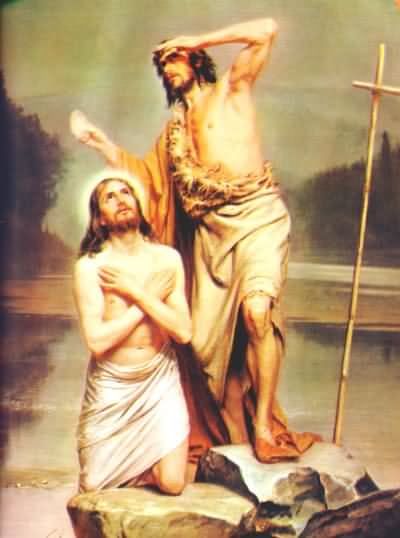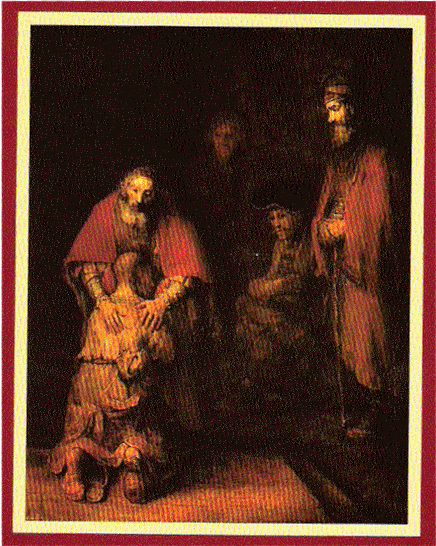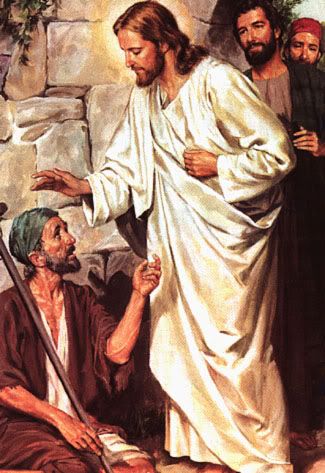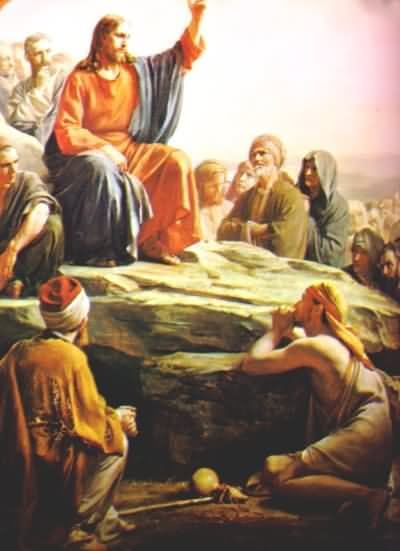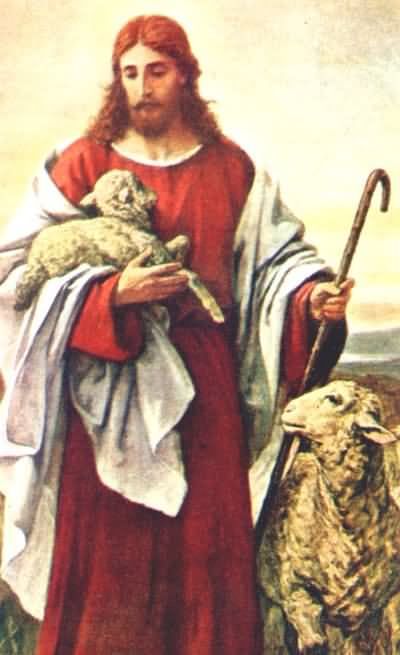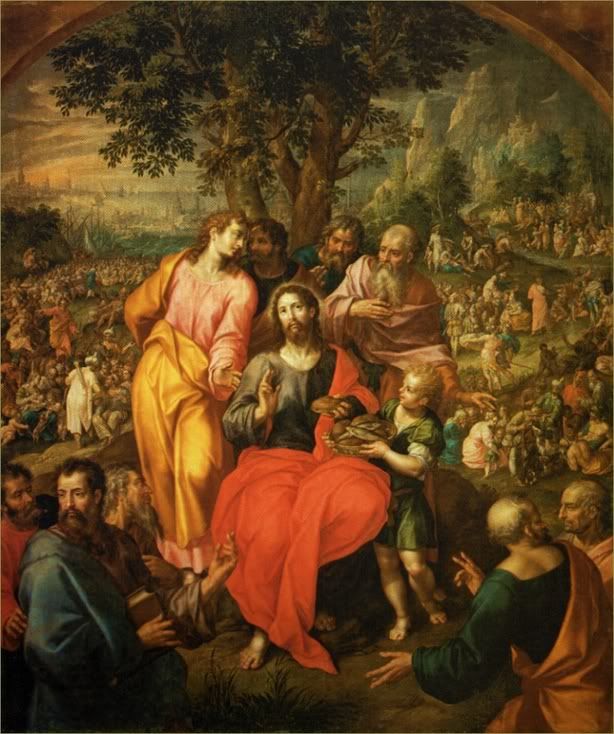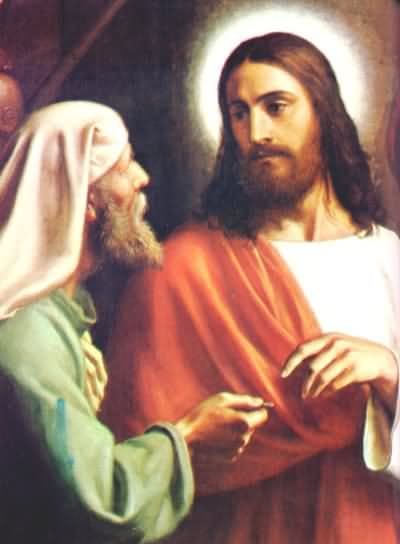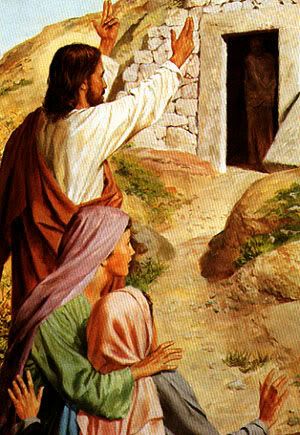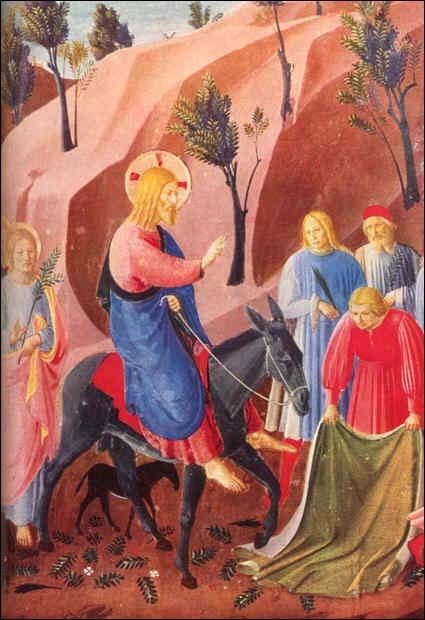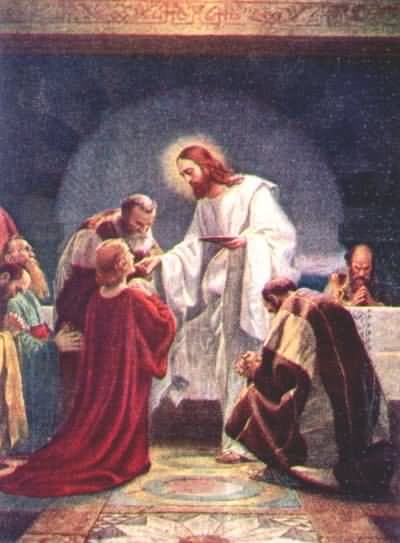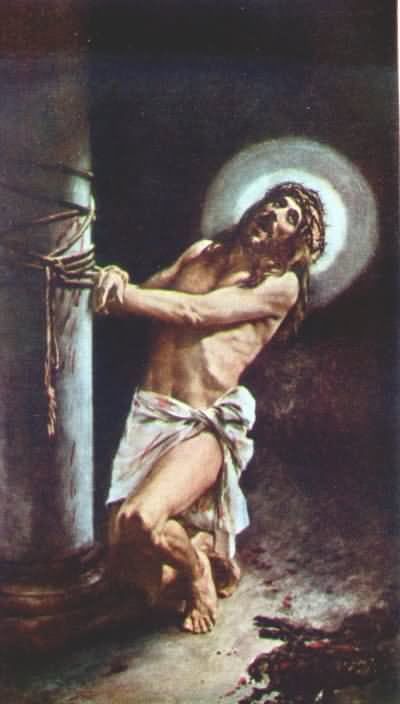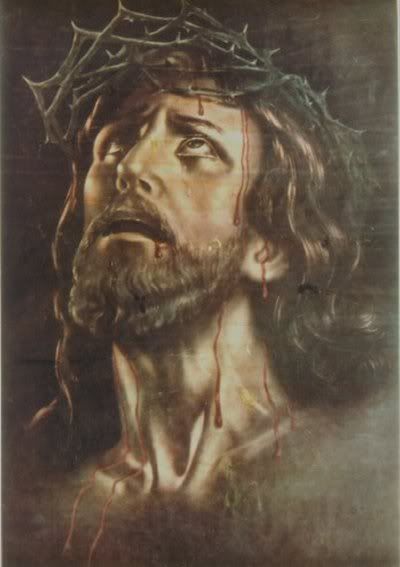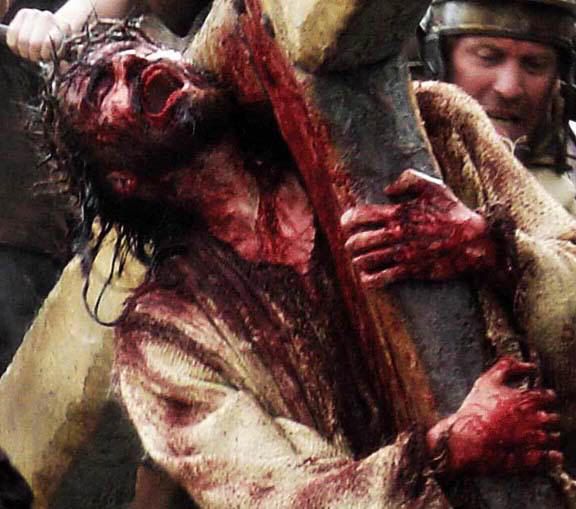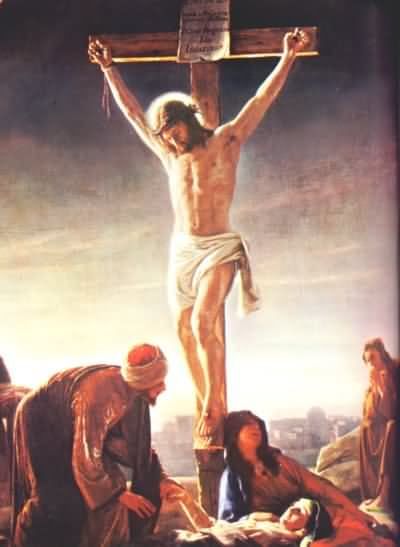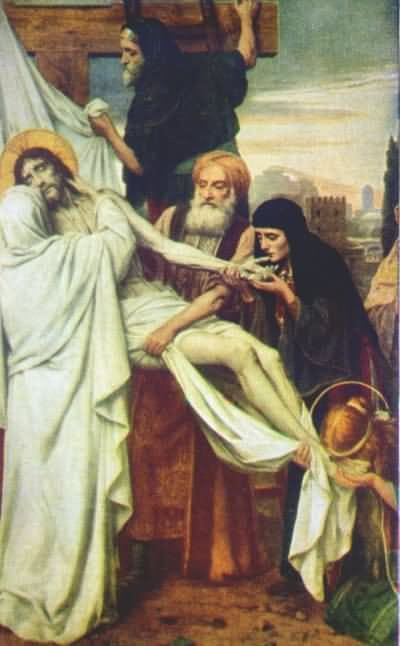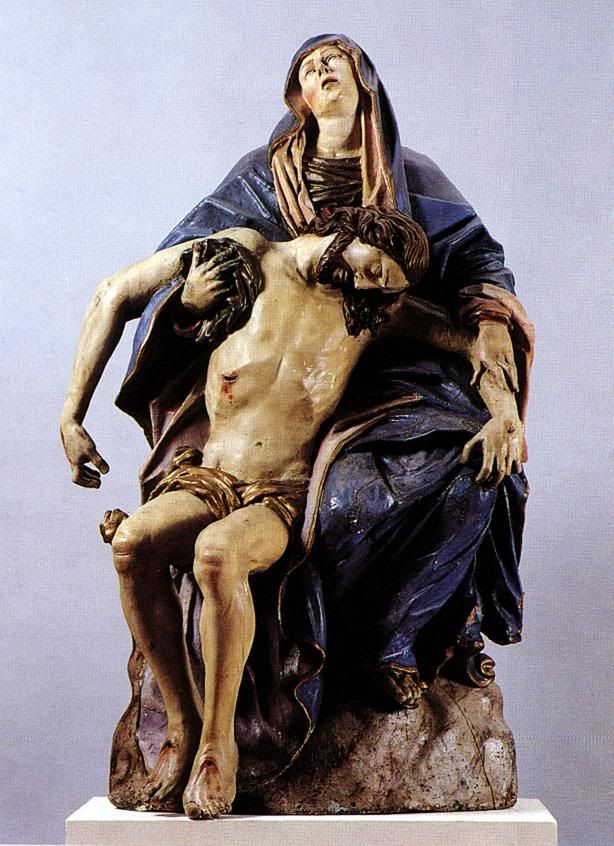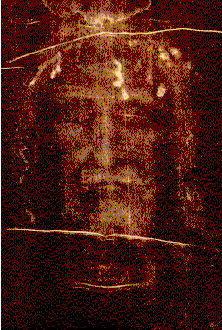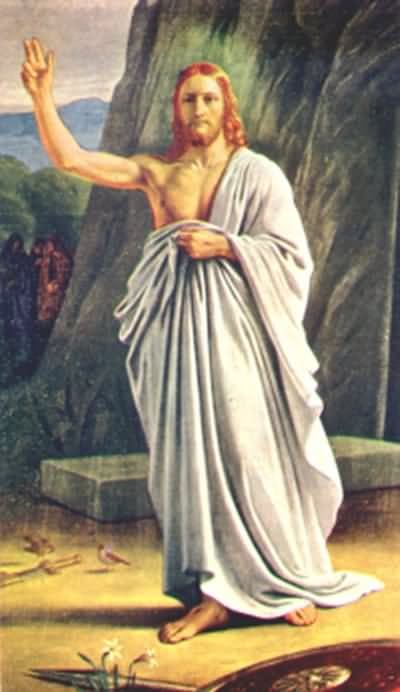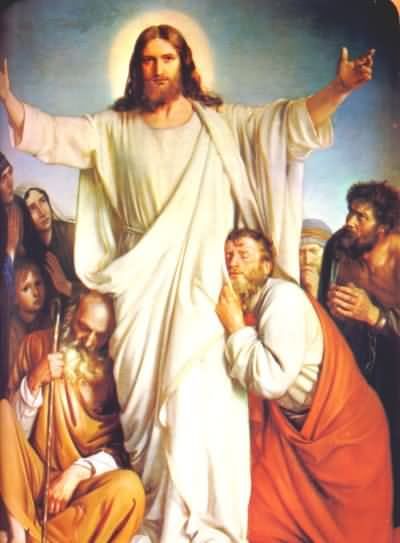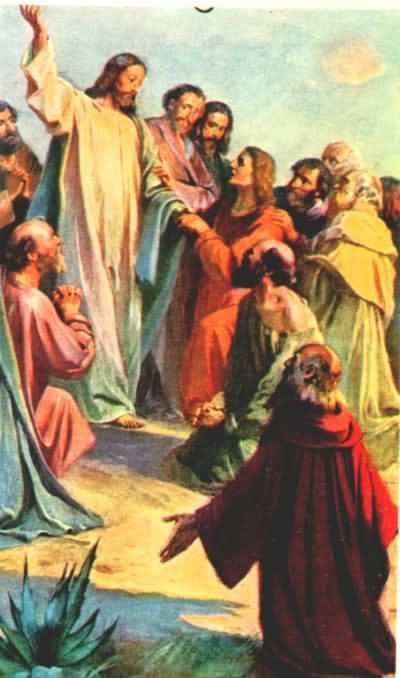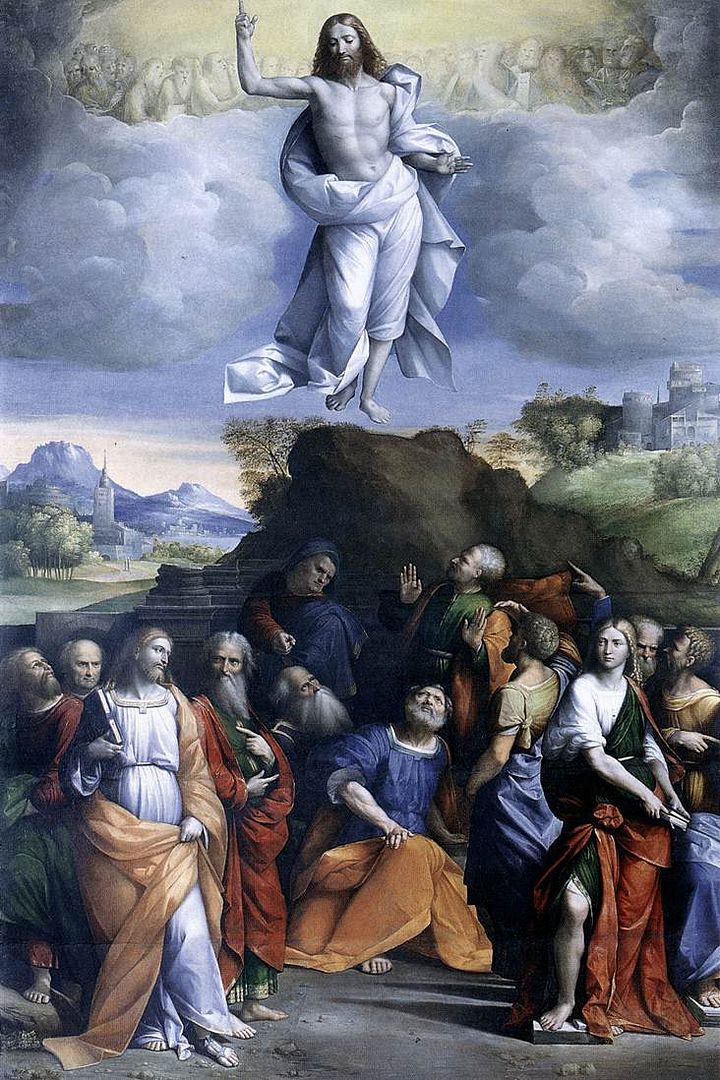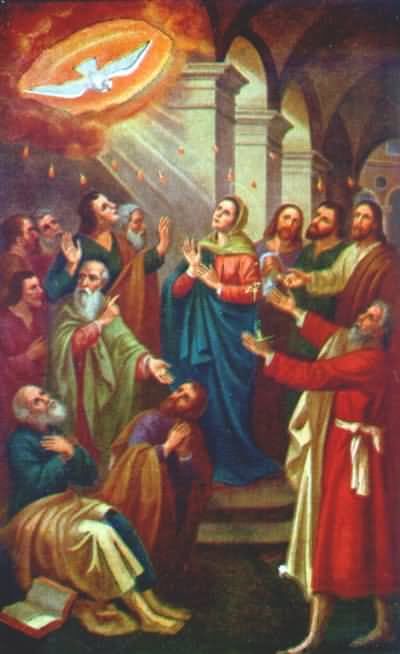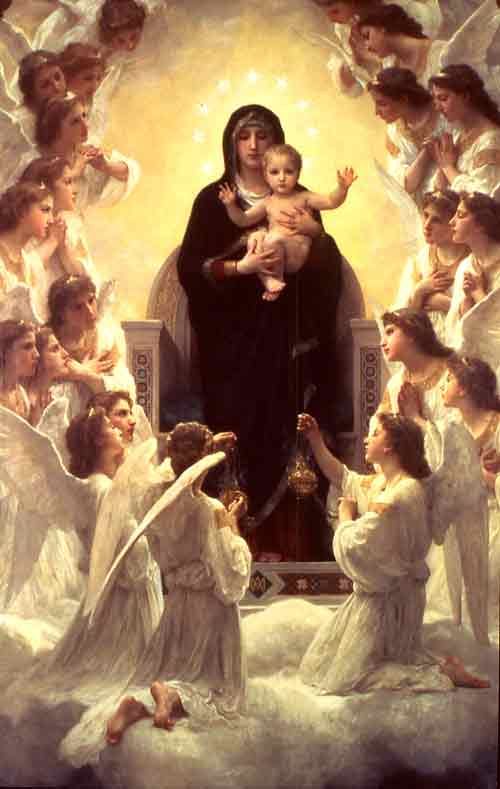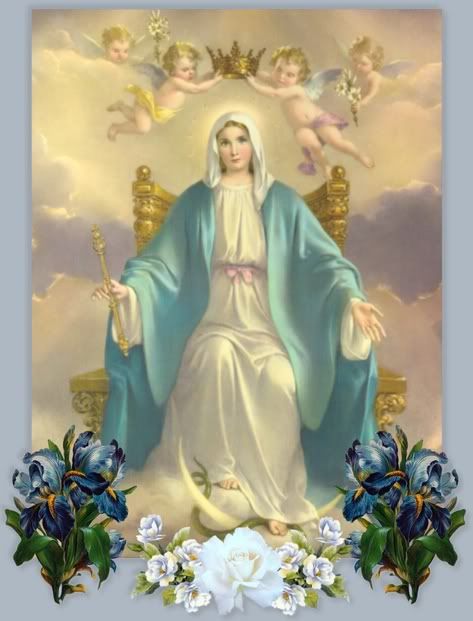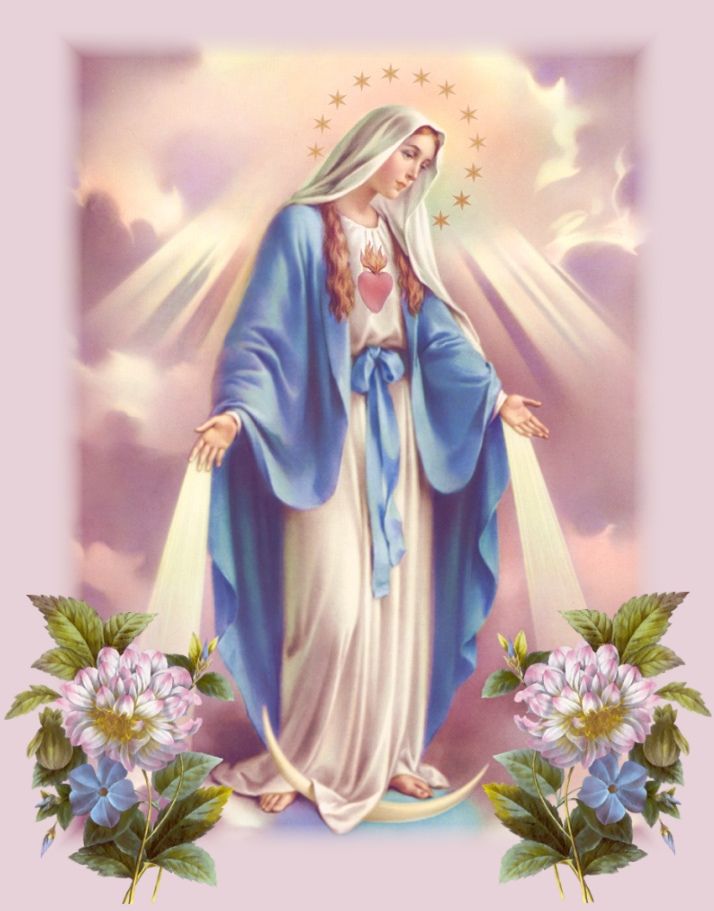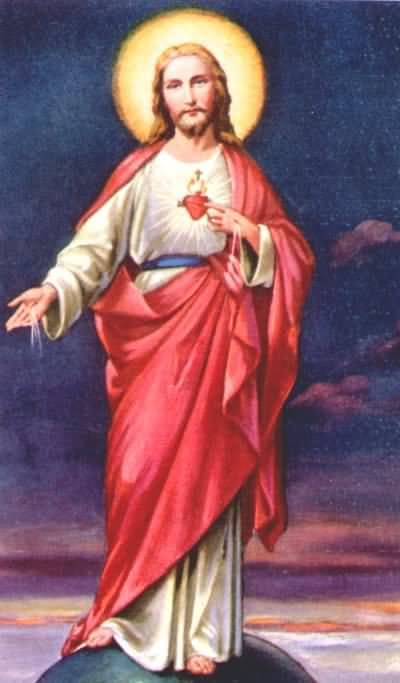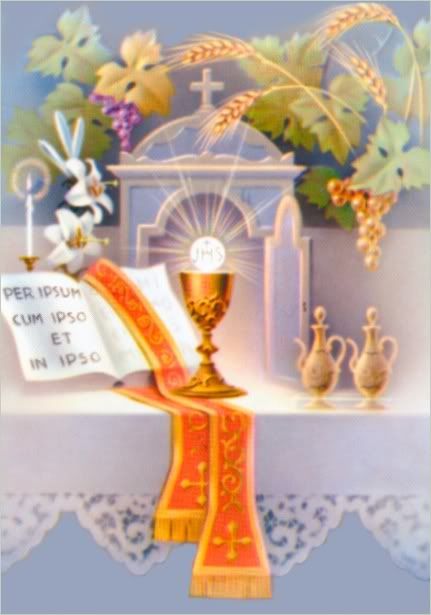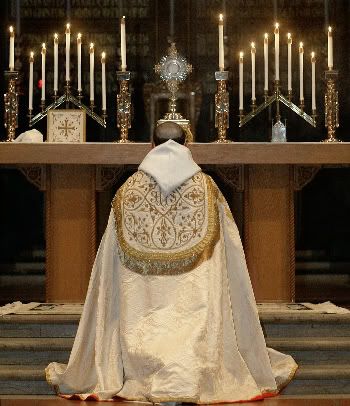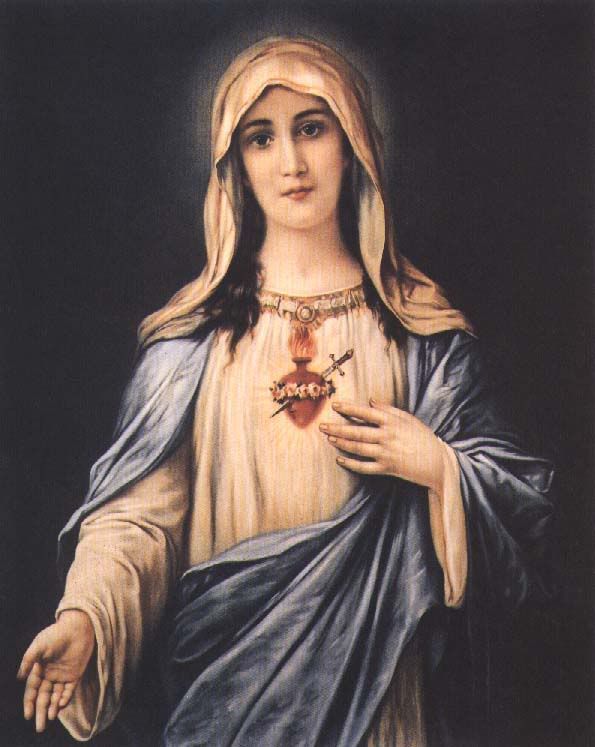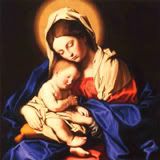Saturday, April 19, 2008
Our Blessed Lady's Saturday

Prayer to the Blessed Virgin to Beg for a Special Grace
from the Holy Ghost
O Mary! Most humble Daughter of the Father, most pure Mother of the Son,
most faithful Spouse of the Holy Ghost, I venerate thee with profound humility.
Mother most merciful, secure Refuge and sweet Advocate of sinners!
I bow before thine Immaculate Heart, Tabernacle of the Most Holy Trinity,
Seat of Wisdom and Goodness; by thy hands I offer my heart to God, the Holy Ghost,
and with all humility, and all confidence, I implore that He grant me,
through thy merits, that which I hope to obtain from His Infinite Goodness. Amen.
[Name your request.]
Labels: Restorationists
The Crescat's Contest
I find that I was nominated for best Church Militant Blog at Carolina Cannonball's contest. I was unaware until about mid-week that such a contest was taking place. I would have thought Best Visual Treat might have been more likely.
Thanks to whoever nominated me, and to the few immensely tasteful and discriminating folks who voted for me.
However, I wasn't even close.

Thanks to whoever nominated me, and to the few immensely tasteful and discriminating folks who voted for me.
However, I wasn't even close.

Labels: Restorationists
The Places Of April 19, 1775
In years past, I have featured numerous reenactment images of the fighting on April 19, 1775. This year, I want to look more closely at the places associated with the beginning of the American Revolutionary War.
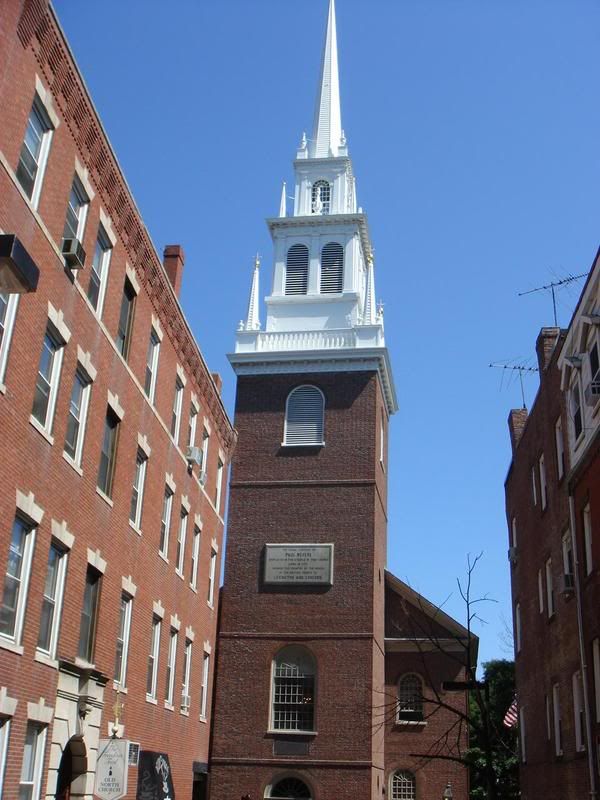
Let's start in Boston, at the Old North Church. This is the church steeple in which Robert Newman hung the two lanterns to tell the Whig leaders in Charlestown that a redcoat force was about to march by land, with its most probable target being Concord. No, the lanterns did not tell Paul Revere about it. He had arranged for the lanterns as a back-up in case he was captured while crossing the ferryway to Charlestown. Revere got across and the lantern scheme proved unnecessary.

A. Lassell Ripley's painting, orignally executed as part of a series for the Paul Revere Life Insurance Company, showing Revere crossing the Charles in a rowboat, virtually under the guns of the 68-gun HMS Somerset.

The Foot of the Common. Now the corner of Boylston Street and Charles Street, between L.J. Peretti's Smokeshop and the grave yard. This is where Lt. Colonel Francis Smith of the 10th Regiment of Foot (being the senior Lt. Col. in the Boston Garrison) and Major John Pitcairn, commander of the Marine Battalion (and the senior Major of the Boston Garrison) assembled their expedition to Concord on the night of April 18th.
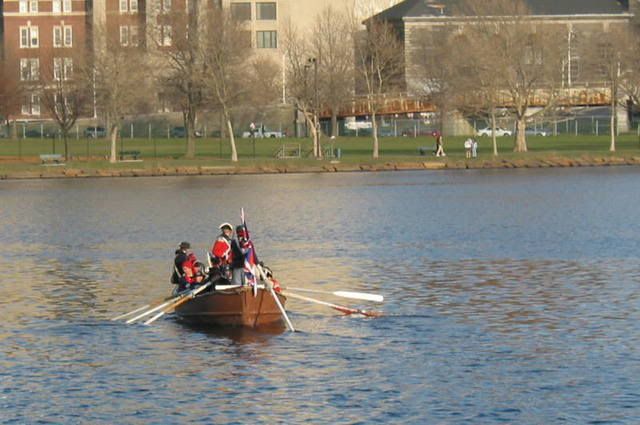
Lechmere Point in East Cambridge. On this marshy shore (now filled in and the site of the Cambridgeside Galleria mall, and formerly the site of the original store of the now defunct Lechmere home appliance store chain) the 11 companies of grenadiers (of the 4th, 5th, 10th, 18th, 23rd, 38th, 43rd, 47th, Marines, 52nd, and 59th Regiments) and 10 companies of light infantry (of the 4th, 5th 10th, 23rd, 38th, 43rd, 47th, Marines, 52nd, and 59th Regiments), landed after being rowed by the navy's boat crews. The ground for a good half mile inland in this remote part of Cambridge was marshy and boggy, not unlike the ground seen around Revere/Saugus/Lynn and further up the North Shore at Ipswich. The troops had to make the best of it.
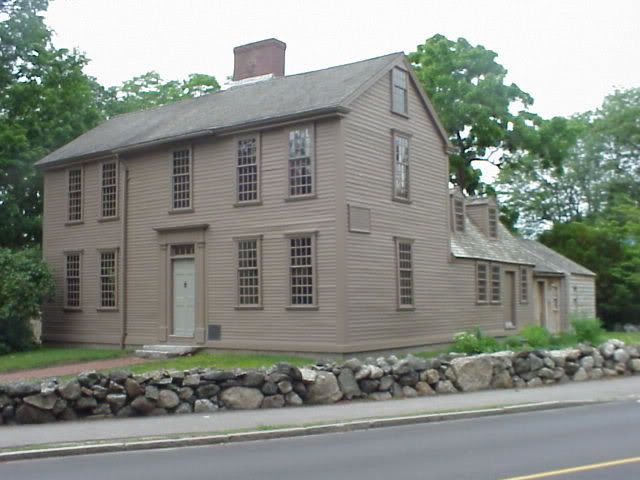
The Hancock Clark House, parsonage of Rev. Jonas Clark, the cousin of John Hancock, and currently host to John Hancock and Samuel Adams, as they attended meetings of the Provincial Congress in Concord. It was here that Revere, and then William Dawes warned Hancock and Adams of the approach of Smith's expedition (as its secondary aim, no doubt covered in verbal orders) was the arrest of these two leaders, and any others that were caught by surprise by the troops.
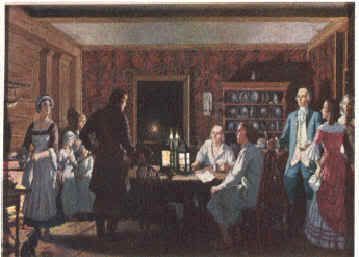
A. Lassell Ripley painting of Revere giving the warning to Hancock and Adams in the great room of the parsonage. Hancock wanted to shoulder a musket and join the Lexington Company on the Green. Adams, Revere, Dawes, and Clark eventually prevailed upon him to seek safety in Burlington, since his capture was part of the objective of the troops' mission.
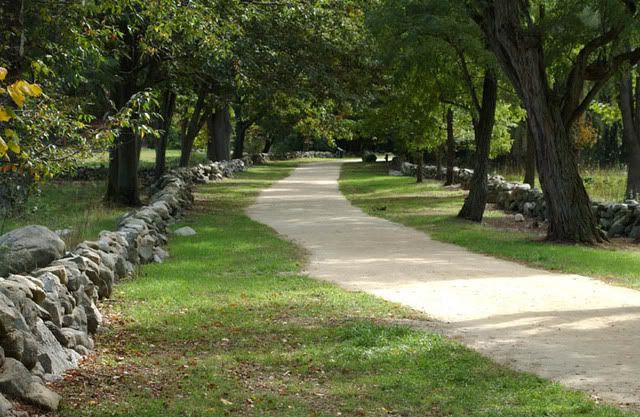
Nelson Road, where Revere, Dawes, and Concord's Dr. Samuel Prescott were warning the inhabitants of the approach of the troops, as they went on to Concord. Concord was not just the meeting place of the Provincial Congress, as sort of rebel rump colonial legislature, meeting in defiance of royal bans on such meetings. It was also a principle arms and accoutrements magazine for the Rebel Army, which had been authorized by the Provincial Congress. Supplies of muskets, cannon, gunpowder, tents, musket balls, leather for belting and harnesses, mess kits, and all sorts of supplies for an army were being stored in Concord. An advance British patrol of officers had ridden by earlier (with the intention of stopping couriers from alerting Concord of the troops' approach), and had a violent encounter with volatile Josiah Nelson. Nelson had apparently showered the officers with some ill-chosen billingsgate, and been rewarded with a whack to the side of his head by the flat of an officer's sword.
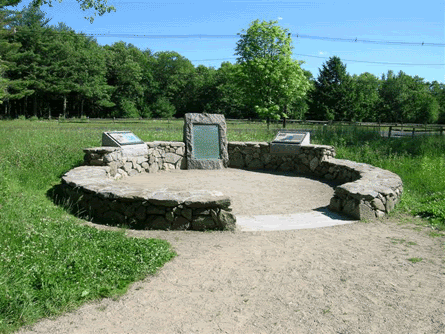
The Paul Revere Capture Site. No, Paul Revere, Longfellow notwithstanding, never made it to Concord that night. A patrol of British officers, led by Major Edward Mitchell of the 5th Regiment, surprised and captured Revere, Dawes, and Prescott. Dawes was able, by a ruse, to get away from the officers, heading back in the direction of Boston. Prescott also escaped, and returned to the road closer to Concord, and actually brought word of Smith's mission to Concord. Revere was most unlucky, and his attempt to escape was prevented. He remained a prisoner for about an hour or so, until the patrol, growing edgy about the sounds of military activity around Lexington Common, let him go, on foot. Revere went back to the Hancock Clark House, to find Adams and Honcock still arguing about whether to go to Burlington or stay put. His story was the final straw in the case for staying put, and Hancock relucantly agreed to leave with Adams.
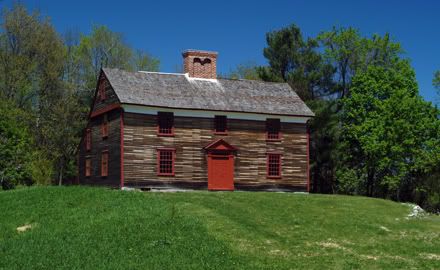
The Captain William Smith House. William Smith was not just the captain of a newly-raised Lincoln minutmen company, he was also the younger brother of Abigail Adams. It was here, about a half mile up the road closer to Concord, that Dr. Prescott regained the road.
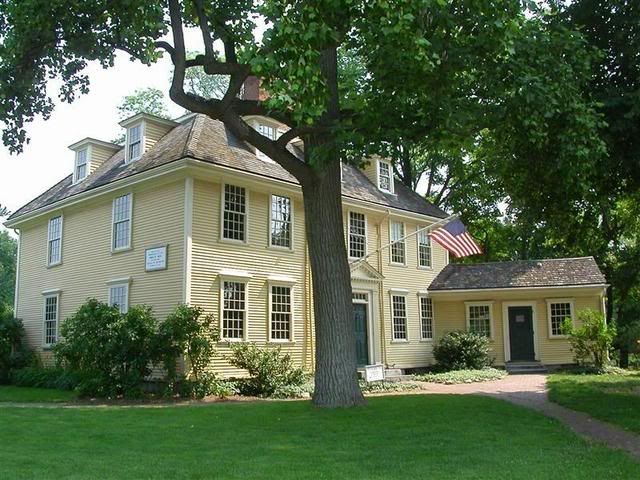
Lexington's Buckman Tavern. This tavern, located just across from the Lexington town common, became the gathering place for Lexington's single large company (around 144 men) of militia. They were not minutemen, as the minutemen had a seperate county-organized regimental structure, and Lexington was slow in complying with the request of the Provincial Congress to create a minute company of picked men from its militia. John Hancock had left a trunk of important documents here, and Revere and Hancock's private secretary were tasked with retrieving this trunk, just as the first light bobs appeared up the road in what is now Lexington Center.
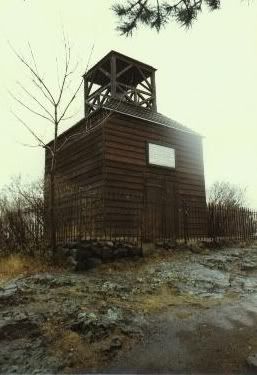
The Lexington belfry, detached from the Meetinghouse and standing next to it, though it has now been relocated to a nearby hill. The bell ringing its alarm and the gathering of the Lexington milita to it was part of what made Major Mitchell release a man who he knew was an important prisoner, Revere.
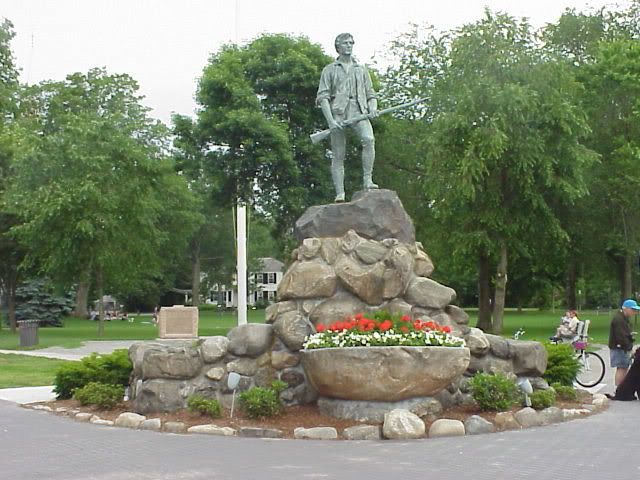
Lexington Common. Imagine no statue, and many fewer stately trees. No flagpole. No benches. The greensward extending into the lanes of both Routes 4 & 225 on our right, and Massachusetts Avenue, on our left. Imagine a box-like meetinghouse where the statue is, the belfry standing behind it. And, of course, no boulder marking the spot where the Lexington militia took up its position. The Hancock Clark House is just a quarter mile up on the right.
Colonel Smith, while still in Menotomy, present-day Arlington, had detached 6 companies of light infantry under Major Pitcairn (10th, 4th, 5th, 23rd, Marines, 52nd) to march ahead of his grenadiers, and seize the two bridges over the Concord River. These met with Major Mitchell and his patrol, and captured various scouts and couriers on the road that early morning. About sunrise, the light infantry came into view, just behind a scout sent out by Captain Parker. Parker's men hastily reassembled on the common.
Pitcairn galloped ahead of his men, and ordered the rebels to lay down their arms and disperse. They did not do that, and the light infantry came up at a run, and began deploying to surround the rebels. A shot rang out. The shot was followed by a volley from the 10th's light company, and then by the 4th's. Then a general melee ensued, as each of the 6 companies broke ranks and surged forward, firing at anything that moved, and bayonetting anything that didn't. The light bobs ignored Pitcairn's repeated orders to reform. Smith came up, and had a drummer beat "To Arms." That brought the men back to a sense of their duty. They reformed on the common, while the grenadiers kept to the road. Smith held a council of war with the officers, while the serjeants raged at the men. The officers were of the opinion that the bloodshed justified returning empty-handed to Boston. But Smith had his orders, and resolved to continue on to Concord to search for supplies. Eight Lexington militia were dead, and more wounded. One light bob of the 10th had been slightly wounded by the return fire of the militia.
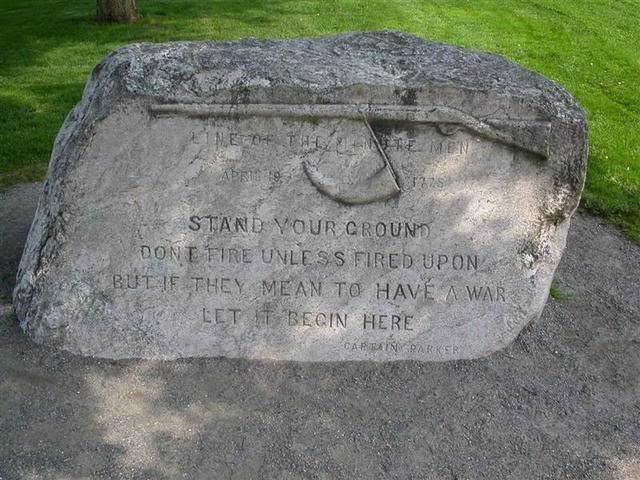
Boulder marking where the militia made their stand. Engraved on it is what Parker allegedly said.
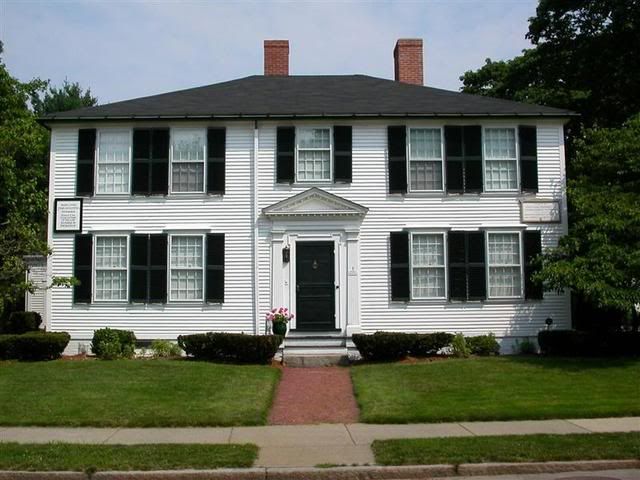
The Jonathan Harrington House, just behind the common. Harrington was a private in the militia company, and received a mortal wound from a musket ball. He dragged himself to his front door, and died in his wife's arms.

The Burial Ground, where the dead militiamen were given a hasty burial. They were later reburied at the sight of the obelisk-style monument erected on the common, between the site of the belfry and that of the schoolhouse.

Concord's Wright's Tavern, in the center of Concord. It was rebel headquarters in Concord, until the approach of the troops forced them back, across the North Bridge, to Punkatasset Hill.
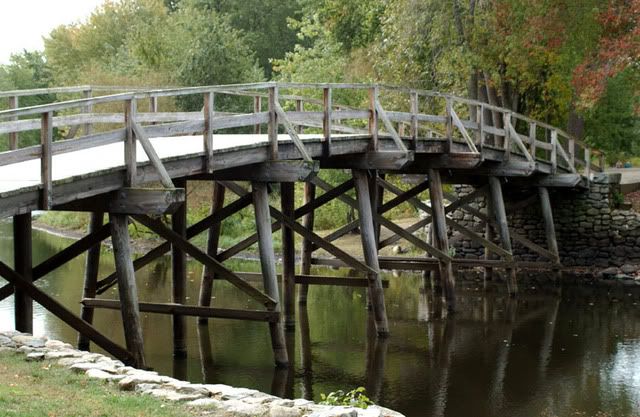
The Old North Bridge. This bridge spanned the Concord River, and was one of two that did so, connecting central Concord with the rest. Three companies of light infantry (4th, 10th, 47th Regiments), about 100 men, held the bridge, under the command of Captain Walter Laurie of the 47th (the 4th's captain, Nesbitt Balfour, was commanding a 100 man detachment in Marshfield on long-term assignment there to protect local loyalists, while the 10th's captain, Lawrence Parsons, was on the other side of the river with 4 companies searching the Barrett Farm). When smoke from burning supplies was seen by the 400 militia and minutemen who had assembled just west of the Buttrick Farm, thinking the town was being put to the torch, the rebels resolved to march to the bridge, and dislodge the redcoats, who they outnumbered 4-1.
Acton's minutemen company commanded by Issac Davis, a blacksmith who had fashioned bayonets for all his men, led the way. The light infantry had not prepared a proper defence, and did not know what to do. They fired on the rebels, and the rebels returned fire. The troops were not prepared properly for the street firing tactic Laurie hoped to use to defend the bridge, and bunched up at the foot of the bridge under heavy fire, until they just turned around and ran back to Concord Center. Smith belatedly came up with two companies of grenadiers as reinforcements. Parsons somehow got past the rebels, and returned safely and without incident to Concord.
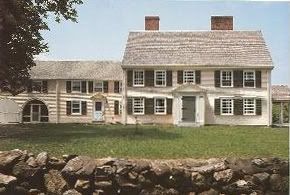
The Buttrick Farm, just above the North Bridge. Major John Buttrick was the second in command of a new-raised regiment of minutemen, part of which came from Concord.

The Old Manse, parsonage of Reverend William Emerson, grandfather of Ralph Waldo Emerson. A crowd of frightened women and children was seeking comfort from their minister here at the parsonage as the rebel troops, and then the redcoats, passed them. The Manse is just adjacent to the side of the Bridge the British ended up on. In the 19th century, Emerson lived there, and for a time rented it to Hawthorne.
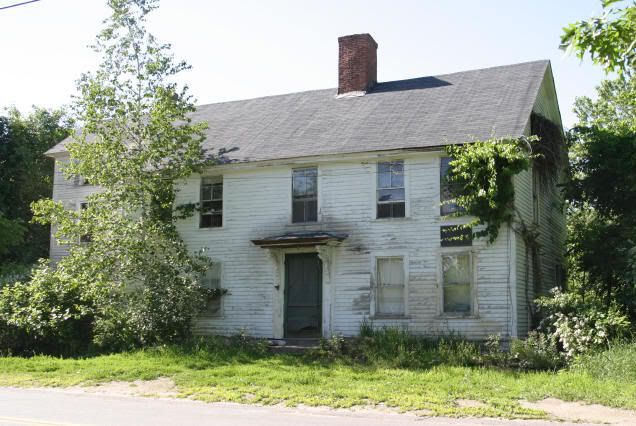
The Barrett Farm. Colonel James Barrett has an important Concordian. He was an influential member of the Provincial Congress. He was also commander of a regiment of militia with some of its companies based in Concord. And his farm was a major rebel supply depot. It is located about 2 miles west of the Old North Bridge. Muskets were literally plowed into the furrows of the fields at the approach of the redcoats, and cannons had just been secreted off to Worcester. It was searched, with little result, by four companies of light infantry (5th, 23rd, 38th, and 52nd) commanded by Captain Lawrence Parsons of the 10th Regiment. The house is currently in a poor state of preservation, because it is so far from the main area connected with the battle. But efforts are now underway to preserve it.
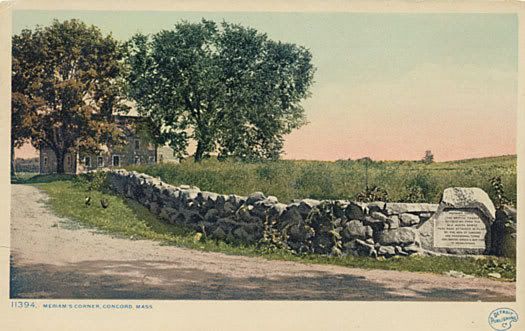
Meriam's Corner. On the road back to Boston, the Meriam farmhouse is about 50 yards north of the road. But a road from Woburn and Reading intersects the Boston road here. It was here that the rebel militia,both veterans of the fight at the bridge, and fresh troops rom Reading, Woburn, and Chelmsford and redcoats collided in the first of a series of engagements that would go on until the grenadiers and light infantry met up with Earl Percy's First Brigade, sent in relief, in Lexington. The grenadiers kept to the road, while the light infantry formed security parties on the flanks, probably about 20-30 yards off the road. It was these light infantry that began the firing on rebel militia dangerously close to the column. The firing from both sides of the road now became general. At Hardy's Hill the numerous companies of Framingham and Sudbury joined the fight, about a half mile down the road and on its southern side.

The Bloody Angles. Actually, the name for this part of the Battle Road is borrowed from a Civil War battlefield. The road to Boston makes 2 90 degree angles here, first to the left, then, further up, to the right. The rebels made good use of cover here to sting the redcoats with musket fire from relatively close range. Most of the shooting was from over 100 yards away, which led to the dismal calculation that only about 1 of every 300 balls fired by the rebels did any damage. But here, the rebels could get in close. But the problem for them was that, getting in close allowed them to be targets for the flanking parties of light infantry trying to protect the column. Casualties on both sides began to climb, but with the troops on the road, or exposed as flanking detachments getting the worst of it. Note that the rebels fired not from behind the stone wall immediately beside the road. That would have been suicidal. They fired from the tree line or wall next back, usually from over 100 yards range.
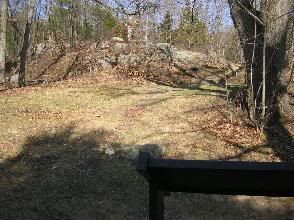
Captain Parker's company of Lexington militia ambushed the redcoats from this pine-filled elevation. It was an excellently chosen location, and just within Lexington's border with Lincoln. Several officers were wounded here, including Col. Smith, in the leg. it was a significant act of leadership for Parker to get his shattered command back together, and get it back in the battle.
The column of redcoats was now in some disorder, and a bluff overlooking the north side of the road as it curves up to Fiske Hill was a vitally important position. If the rebels held it, they could pour fire directly into the column below. Major Pitcairn ordered his own companies of Marine light infantry and grenadiers to hold this position (they were over twice the size of the regular army companies, which on paper had only 38 privates and corporals, 2 serjeants, and 3 officers each). There was heavy fighting, but Pitcairn's men held the bluff until the rearguard got by. Then the rebels gained possession.
Fiske Hill Fresh rebel companies from Cambridge joined the battle here, and the fighting was severe. Pitcairn's horse bolted, and was captured by the rebels, along with his fine Scottish pistols in the saddle holsters. The column was now temporarily leaderless with Smith among the wounded, and Pitcairn temporarily out of action. The disorder increased. The men at this point were almost out of ammunition, and were now running away rather than fighting.
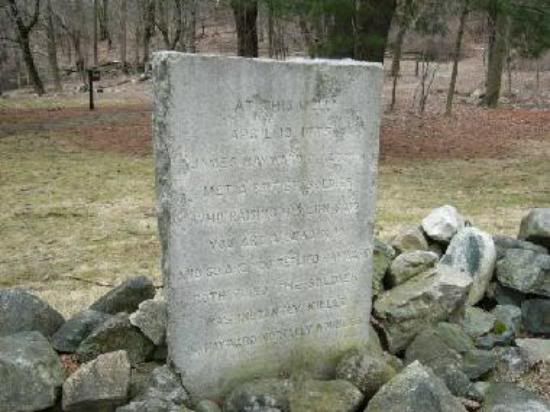
Hayward's Well Adjacent to the Ebenezer Fiske House (which no longer stands, but its foundation line is maked out by stones). Here, very close to the road, probably as the rear guard had just passed, and a few redcoated stragglers tried to keep up, James Hayward of Acton and an unnamed redcoat shot each other, and both died. The column now descended into a valley between Fiske Hill and Concord Hill, through which now runs Route 128. When it topped Concord Hill, the company officers got to the front, and forced the men to reform, under a heavy rebel fire. But on the other side of Lexington, all could now see the 32 companies of Earl Percy's First Brigade (the 8 battalion companies of the 4th, 23rd, 47th, and Marines) drawn up, with two Royal Artillery six-pounder cannon.
Rebel pressure on the flanks ceased after they got a taste of Percy's cannon. Smith's shattered command limped across Lexington common and rested under the protection of Percy's men for about a half hour. It was now around 3pm, and the column had a long way to go to get back to Boston, while more rebel companies poured in from Middlesex, Essex, Norfolk, and Worcester counties.

The Monroe Tavern This building became the de facto headquarters for Lord Percy as his brigade protected the remnants of Smith's command. Smith's forces reformed and refreshed themselves. The wounded were treated either in the tavern or on its grounds by the few medical personnel available (essentially a surgeon's mate of the 43rd Regiment named Simms). The 23rd Foot (Royal Welch Fusiliers) now replaced Captain Harris's pressed grenadier company of the 5th as the rear guard. After burning some of the surrounding houses lest they become nests of rebel snipers, Percy began his march back to Boston.
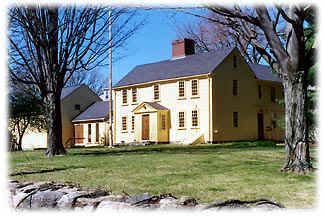
The Jason Russell House Jason Russell was a man in his late 50s, partially lame, who chose to defend his farmhouse. He was joined by numerous militia and minutemen from Danvers, Lynn, and Needham. But Percy's flanking parties, fresh from heavy fighting at the Foot of the Rocks, modern Arlington Heights, were too good, and 12 militia were killed around Russell's house, including Russell himself.

Samuel Whittemore was an 79 year old man exempt from militia service. Nevertheless, this Indian wars veteran took his musket, his sword, and a brace of pistols with him, and decided to meet the column on his own. He killed or wounded several troops, before he was shot and bayoneted 13 times, and beaten with musket butts. He was left for dead, and the rebel surgeons refused to treat him as a lost cause, but he recovered and lived 18 years more.
Percy forced his way through a rebel trap, which was an effort to force his column to march over the "Great Bridge" over the Charles (which was the way Percy had come out from Boston) instead of the shorter route via Charlestown. The rebels had prepared an elaborae ambush at the Great Bridge, having taken up the planks again, and used them as a barricade on the opposite bank, with lots of rebel militia lining the banks and on the flanks of the road. Percy unlimered his guns again and blasted his way through the ambush, and took the shorter route to Charlestown. That brought his men under the protection of the guns of the navy, and because of the shape of the Charlestown Peninsula and its narrow neck, the rebels could not follow. His men rested atop Bunker Hill and all over Charlestown, while the wounded were ferried over. Fresh troops from the now thin Boston garrison secured Charlestown Neck. The next morning, Percy's men were ferried back to Boston. Two months later, the redcoats would have to fight even harder and suffer even more casualties to recapture Bunker Hill.

Let's start in Boston, at the Old North Church. This is the church steeple in which Robert Newman hung the two lanterns to tell the Whig leaders in Charlestown that a redcoat force was about to march by land, with its most probable target being Concord. No, the lanterns did not tell Paul Revere about it. He had arranged for the lanterns as a back-up in case he was captured while crossing the ferryway to Charlestown. Revere got across and the lantern scheme proved unnecessary.

A. Lassell Ripley's painting, orignally executed as part of a series for the Paul Revere Life Insurance Company, showing Revere crossing the Charles in a rowboat, virtually under the guns of the 68-gun HMS Somerset.

The Foot of the Common. Now the corner of Boylston Street and Charles Street, between L.J. Peretti's Smokeshop and the grave yard. This is where Lt. Colonel Francis Smith of the 10th Regiment of Foot (being the senior Lt. Col. in the Boston Garrison) and Major John Pitcairn, commander of the Marine Battalion (and the senior Major of the Boston Garrison) assembled their expedition to Concord on the night of April 18th.

Lechmere Point in East Cambridge. On this marshy shore (now filled in and the site of the Cambridgeside Galleria mall, and formerly the site of the original store of the now defunct Lechmere home appliance store chain) the 11 companies of grenadiers (of the 4th, 5th, 10th, 18th, 23rd, 38th, 43rd, 47th, Marines, 52nd, and 59th Regiments) and 10 companies of light infantry (of the 4th, 5th 10th, 23rd, 38th, 43rd, 47th, Marines, 52nd, and 59th Regiments), landed after being rowed by the navy's boat crews. The ground for a good half mile inland in this remote part of Cambridge was marshy and boggy, not unlike the ground seen around Revere/Saugus/Lynn and further up the North Shore at Ipswich. The troops had to make the best of it.

The Hancock Clark House, parsonage of Rev. Jonas Clark, the cousin of John Hancock, and currently host to John Hancock and Samuel Adams, as they attended meetings of the Provincial Congress in Concord. It was here that Revere, and then William Dawes warned Hancock and Adams of the approach of Smith's expedition (as its secondary aim, no doubt covered in verbal orders) was the arrest of these two leaders, and any others that were caught by surprise by the troops.

A. Lassell Ripley painting of Revere giving the warning to Hancock and Adams in the great room of the parsonage. Hancock wanted to shoulder a musket and join the Lexington Company on the Green. Adams, Revere, Dawes, and Clark eventually prevailed upon him to seek safety in Burlington, since his capture was part of the objective of the troops' mission.

Nelson Road, where Revere, Dawes, and Concord's Dr. Samuel Prescott were warning the inhabitants of the approach of the troops, as they went on to Concord. Concord was not just the meeting place of the Provincial Congress, as sort of rebel rump colonial legislature, meeting in defiance of royal bans on such meetings. It was also a principle arms and accoutrements magazine for the Rebel Army, which had been authorized by the Provincial Congress. Supplies of muskets, cannon, gunpowder, tents, musket balls, leather for belting and harnesses, mess kits, and all sorts of supplies for an army were being stored in Concord. An advance British patrol of officers had ridden by earlier (with the intention of stopping couriers from alerting Concord of the troops' approach), and had a violent encounter with volatile Josiah Nelson. Nelson had apparently showered the officers with some ill-chosen billingsgate, and been rewarded with a whack to the side of his head by the flat of an officer's sword.

The Paul Revere Capture Site. No, Paul Revere, Longfellow notwithstanding, never made it to Concord that night. A patrol of British officers, led by Major Edward Mitchell of the 5th Regiment, surprised and captured Revere, Dawes, and Prescott. Dawes was able, by a ruse, to get away from the officers, heading back in the direction of Boston. Prescott also escaped, and returned to the road closer to Concord, and actually brought word of Smith's mission to Concord. Revere was most unlucky, and his attempt to escape was prevented. He remained a prisoner for about an hour or so, until the patrol, growing edgy about the sounds of military activity around Lexington Common, let him go, on foot. Revere went back to the Hancock Clark House, to find Adams and Honcock still arguing about whether to go to Burlington or stay put. His story was the final straw in the case for staying put, and Hancock relucantly agreed to leave with Adams.

The Captain William Smith House. William Smith was not just the captain of a newly-raised Lincoln minutmen company, he was also the younger brother of Abigail Adams. It was here, about a half mile up the road closer to Concord, that Dr. Prescott regained the road.

Lexington's Buckman Tavern. This tavern, located just across from the Lexington town common, became the gathering place for Lexington's single large company (around 144 men) of militia. They were not minutemen, as the minutemen had a seperate county-organized regimental structure, and Lexington was slow in complying with the request of the Provincial Congress to create a minute company of picked men from its militia. John Hancock had left a trunk of important documents here, and Revere and Hancock's private secretary were tasked with retrieving this trunk, just as the first light bobs appeared up the road in what is now Lexington Center.

The Lexington belfry, detached from the Meetinghouse and standing next to it, though it has now been relocated to a nearby hill. The bell ringing its alarm and the gathering of the Lexington milita to it was part of what made Major Mitchell release a man who he knew was an important prisoner, Revere.

Lexington Common. Imagine no statue, and many fewer stately trees. No flagpole. No benches. The greensward extending into the lanes of both Routes 4 & 225 on our right, and Massachusetts Avenue, on our left. Imagine a box-like meetinghouse where the statue is, the belfry standing behind it. And, of course, no boulder marking the spot where the Lexington militia took up its position. The Hancock Clark House is just a quarter mile up on the right.
Colonel Smith, while still in Menotomy, present-day Arlington, had detached 6 companies of light infantry under Major Pitcairn (10th, 4th, 5th, 23rd, Marines, 52nd) to march ahead of his grenadiers, and seize the two bridges over the Concord River. These met with Major Mitchell and his patrol, and captured various scouts and couriers on the road that early morning. About sunrise, the light infantry came into view, just behind a scout sent out by Captain Parker. Parker's men hastily reassembled on the common.
Pitcairn galloped ahead of his men, and ordered the rebels to lay down their arms and disperse. They did not do that, and the light infantry came up at a run, and began deploying to surround the rebels. A shot rang out. The shot was followed by a volley from the 10th's light company, and then by the 4th's. Then a general melee ensued, as each of the 6 companies broke ranks and surged forward, firing at anything that moved, and bayonetting anything that didn't. The light bobs ignored Pitcairn's repeated orders to reform. Smith came up, and had a drummer beat "To Arms." That brought the men back to a sense of their duty. They reformed on the common, while the grenadiers kept to the road. Smith held a council of war with the officers, while the serjeants raged at the men. The officers were of the opinion that the bloodshed justified returning empty-handed to Boston. But Smith had his orders, and resolved to continue on to Concord to search for supplies. Eight Lexington militia were dead, and more wounded. One light bob of the 10th had been slightly wounded by the return fire of the militia.

Boulder marking where the militia made their stand. Engraved on it is what Parker allegedly said.

The Jonathan Harrington House, just behind the common. Harrington was a private in the militia company, and received a mortal wound from a musket ball. He dragged himself to his front door, and died in his wife's arms.

The Burial Ground, where the dead militiamen were given a hasty burial. They were later reburied at the sight of the obelisk-style monument erected on the common, between the site of the belfry and that of the schoolhouse.

Concord's Wright's Tavern, in the center of Concord. It was rebel headquarters in Concord, until the approach of the troops forced them back, across the North Bridge, to Punkatasset Hill.

The Old North Bridge. This bridge spanned the Concord River, and was one of two that did so, connecting central Concord with the rest. Three companies of light infantry (4th, 10th, 47th Regiments), about 100 men, held the bridge, under the command of Captain Walter Laurie of the 47th (the 4th's captain, Nesbitt Balfour, was commanding a 100 man detachment in Marshfield on long-term assignment there to protect local loyalists, while the 10th's captain, Lawrence Parsons, was on the other side of the river with 4 companies searching the Barrett Farm). When smoke from burning supplies was seen by the 400 militia and minutemen who had assembled just west of the Buttrick Farm, thinking the town was being put to the torch, the rebels resolved to march to the bridge, and dislodge the redcoats, who they outnumbered 4-1.
Acton's minutemen company commanded by Issac Davis, a blacksmith who had fashioned bayonets for all his men, led the way. The light infantry had not prepared a proper defence, and did not know what to do. They fired on the rebels, and the rebels returned fire. The troops were not prepared properly for the street firing tactic Laurie hoped to use to defend the bridge, and bunched up at the foot of the bridge under heavy fire, until they just turned around and ran back to Concord Center. Smith belatedly came up with two companies of grenadiers as reinforcements. Parsons somehow got past the rebels, and returned safely and without incident to Concord.

The Buttrick Farm, just above the North Bridge. Major John Buttrick was the second in command of a new-raised regiment of minutemen, part of which came from Concord.

The Old Manse, parsonage of Reverend William Emerson, grandfather of Ralph Waldo Emerson. A crowd of frightened women and children was seeking comfort from their minister here at the parsonage as the rebel troops, and then the redcoats, passed them. The Manse is just adjacent to the side of the Bridge the British ended up on. In the 19th century, Emerson lived there, and for a time rented it to Hawthorne.

The Barrett Farm. Colonel James Barrett has an important Concordian. He was an influential member of the Provincial Congress. He was also commander of a regiment of militia with some of its companies based in Concord. And his farm was a major rebel supply depot. It is located about 2 miles west of the Old North Bridge. Muskets were literally plowed into the furrows of the fields at the approach of the redcoats, and cannons had just been secreted off to Worcester. It was searched, with little result, by four companies of light infantry (5th, 23rd, 38th, and 52nd) commanded by Captain Lawrence Parsons of the 10th Regiment. The house is currently in a poor state of preservation, because it is so far from the main area connected with the battle. But efforts are now underway to preserve it.

Meriam's Corner. On the road back to Boston, the Meriam farmhouse is about 50 yards north of the road. But a road from Woburn and Reading intersects the Boston road here. It was here that the rebel militia,both veterans of the fight at the bridge, and fresh troops rom Reading, Woburn, and Chelmsford and redcoats collided in the first of a series of engagements that would go on until the grenadiers and light infantry met up with Earl Percy's First Brigade, sent in relief, in Lexington. The grenadiers kept to the road, while the light infantry formed security parties on the flanks, probably about 20-30 yards off the road. It was these light infantry that began the firing on rebel militia dangerously close to the column. The firing from both sides of the road now became general. At Hardy's Hill the numerous companies of Framingham and Sudbury joined the fight, about a half mile down the road and on its southern side.

The Bloody Angles. Actually, the name for this part of the Battle Road is borrowed from a Civil War battlefield. The road to Boston makes 2 90 degree angles here, first to the left, then, further up, to the right. The rebels made good use of cover here to sting the redcoats with musket fire from relatively close range. Most of the shooting was from over 100 yards away, which led to the dismal calculation that only about 1 of every 300 balls fired by the rebels did any damage. But here, the rebels could get in close. But the problem for them was that, getting in close allowed them to be targets for the flanking parties of light infantry trying to protect the column. Casualties on both sides began to climb, but with the troops on the road, or exposed as flanking detachments getting the worst of it. Note that the rebels fired not from behind the stone wall immediately beside the road. That would have been suicidal. They fired from the tree line or wall next back, usually from over 100 yards range.

Captain Parker's company of Lexington militia ambushed the redcoats from this pine-filled elevation. It was an excellently chosen location, and just within Lexington's border with Lincoln. Several officers were wounded here, including Col. Smith, in the leg. it was a significant act of leadership for Parker to get his shattered command back together, and get it back in the battle.
The column of redcoats was now in some disorder, and a bluff overlooking the north side of the road as it curves up to Fiske Hill was a vitally important position. If the rebels held it, they could pour fire directly into the column below. Major Pitcairn ordered his own companies of Marine light infantry and grenadiers to hold this position (they were over twice the size of the regular army companies, which on paper had only 38 privates and corporals, 2 serjeants, and 3 officers each). There was heavy fighting, but Pitcairn's men held the bluff until the rearguard got by. Then the rebels gained possession.
Fiske Hill Fresh rebel companies from Cambridge joined the battle here, and the fighting was severe. Pitcairn's horse bolted, and was captured by the rebels, along with his fine Scottish pistols in the saddle holsters. The column was now temporarily leaderless with Smith among the wounded, and Pitcairn temporarily out of action. The disorder increased. The men at this point were almost out of ammunition, and were now running away rather than fighting.

Hayward's Well Adjacent to the Ebenezer Fiske House (which no longer stands, but its foundation line is maked out by stones). Here, very close to the road, probably as the rear guard had just passed, and a few redcoated stragglers tried to keep up, James Hayward of Acton and an unnamed redcoat shot each other, and both died. The column now descended into a valley between Fiske Hill and Concord Hill, through which now runs Route 128. When it topped Concord Hill, the company officers got to the front, and forced the men to reform, under a heavy rebel fire. But on the other side of Lexington, all could now see the 32 companies of Earl Percy's First Brigade (the 8 battalion companies of the 4th, 23rd, 47th, and Marines) drawn up, with two Royal Artillery six-pounder cannon.
Rebel pressure on the flanks ceased after they got a taste of Percy's cannon. Smith's shattered command limped across Lexington common and rested under the protection of Percy's men for about a half hour. It was now around 3pm, and the column had a long way to go to get back to Boston, while more rebel companies poured in from Middlesex, Essex, Norfolk, and Worcester counties.

The Monroe Tavern This building became the de facto headquarters for Lord Percy as his brigade protected the remnants of Smith's command. Smith's forces reformed and refreshed themselves. The wounded were treated either in the tavern or on its grounds by the few medical personnel available (essentially a surgeon's mate of the 43rd Regiment named Simms). The 23rd Foot (Royal Welch Fusiliers) now replaced Captain Harris's pressed grenadier company of the 5th as the rear guard. After burning some of the surrounding houses lest they become nests of rebel snipers, Percy began his march back to Boston.

The Jason Russell House Jason Russell was a man in his late 50s, partially lame, who chose to defend his farmhouse. He was joined by numerous militia and minutemen from Danvers, Lynn, and Needham. But Percy's flanking parties, fresh from heavy fighting at the Foot of the Rocks, modern Arlington Heights, were too good, and 12 militia were killed around Russell's house, including Russell himself.

Samuel Whittemore was an 79 year old man exempt from militia service. Nevertheless, this Indian wars veteran took his musket, his sword, and a brace of pistols with him, and decided to meet the column on his own. He killed or wounded several troops, before he was shot and bayoneted 13 times, and beaten with musket butts. He was left for dead, and the rebel surgeons refused to treat him as a lost cause, but he recovered and lived 18 years more.
Percy forced his way through a rebel trap, which was an effort to force his column to march over the "Great Bridge" over the Charles (which was the way Percy had come out from Boston) instead of the shorter route via Charlestown. The rebels had prepared an elaborae ambush at the Great Bridge, having taken up the planks again, and used them as a barricade on the opposite bank, with lots of rebel militia lining the banks and on the flanks of the road. Percy unlimered his guns again and blasted his way through the ambush, and took the shorter route to Charlestown. That brought his men under the protection of the guns of the navy, and because of the shape of the Charlestown Peninsula and its narrow neck, the rebels could not follow. His men rested atop Bunker Hill and all over Charlestown, while the wounded were ferried over. Fresh troops from the now thin Boston garrison secured Charlestown Neck. The next morning, Percy's men were ferried back to Boston. Two months later, the redcoats would have to fight even harder and suffer even more casualties to recapture Bunker Hill.
Labels: American Revolution
Friday, April 18, 2008
Friday At the Foot Of the Cross
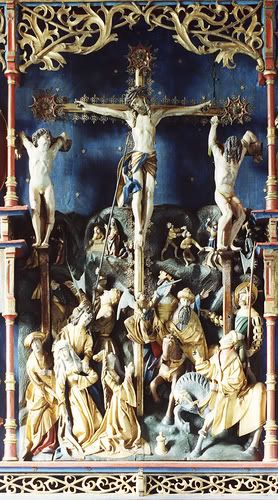
Prayer for Pardon and Grace
O Divine Redeemer!
humbly prostrate at the foot of Thy Cross,
I call upon Thee to incline Thy Sacred Heart to pardon me.
Jesus, misjudged and despised-----have mercy on me!
Jesus, calumniated and persecuted-----have mercy on me!
Jesus, abandoned by men and tempted in the desert-----have mercy on me!
Jesus, betrayed and sold-----have mercy on me!
Jesus, insulted, accused, and unjustly condemned-----have mercy on me!
Jesus, clothed in a robe of ignominy and contempt-----have mercy on me!
Jesus, mocked and scoffed at-----have mercy on me!
Jesus, bound with cords and led through the streets-----have mercy on me!
Jesus, treated as a fool and classed with malefactors-----have mercy on me!
Jesus, cruelly scourged-----have mercy on me!
Jesus, held inferior to Barabbas-----have mercy on me!
Jesus, despoiled of Thy garments-----have mercy on me!
Jesus, crowned with thorns and reviled-----have mercy on me!
Jesus, bearing the Cross amid the maledictions of the people-----have mercy on me!
Jesus, bowed down by ignominies, pain, and humiliations-----have mercy on me!
Jesus, crucified between thieves-----have mercy on me!
Jesus, dying for my sins amid all kinds of suffering-----have mercy on me!
LET US PRAY:
SACRED HEART of Jesus, my Redeemer! Exercise, I beseech Thee, Thy office of mediator with me, and permit not that Thy sufferings and cruel death be in vain for my salvation, but let them bring forth, for Thy glory, fruits of salvation in me, that my heart may love, praise, and glorify Thee for ever and ever. Amen.
Labels: Restorationists
Wednesday, April 16, 2008
Peter Is Here In the USA!!!
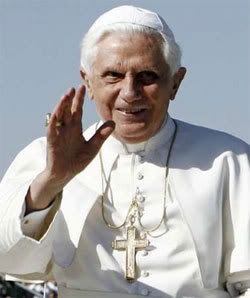
Long live the Pope His praises sound again and yet again
His rule is over space and time His throne the hearts of men
All hail the Shepherd King of Rome The theme of loving song
Let all the earth is glory sing And heav'n the strain prolong.
Beleaguered by the foes of earth Be set by hosts of hell.
He guards the loyal flock of Christ A watchful sentinel
And yet amid the din and strife The clash of mace and sword
He bears alone the shepherd staff This champion of the Lord.
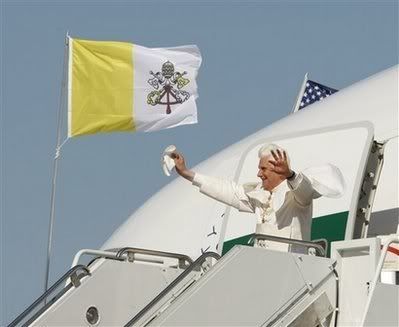
And today is the Holy Father's 81st birthday.
Happy Birthday, Holy Father!!!
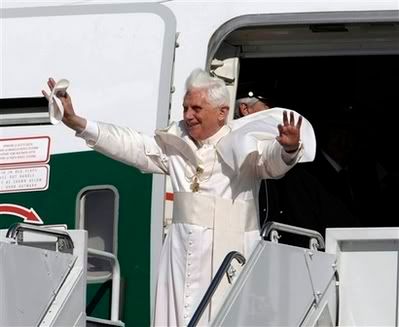
Prayer From The Raccolta
O Lord, we are the millions of believers, humbly kneeling at Thy feet and begging Thee to preserve, defend and save the Sovereign Pontiff for many years. He is the Father of the great fellowship of souls and our Father as well. On this day, as on every other day, he is praying for us also, and is offering unto Thee with holy fervor the sacred Victim of love and peace.
Wherefore, O Lord, turn Thyself toward us with eyes of pity; for we are now, as it were, forgetful of ourselves, and are praying above all for him. Do Thou unite our prayers with his and receive them into the bosom of Thine infinite mercy, as a sweet savor of active and fruitful charity, whereby the children are united in the Church to their Father. All that he asks of Thee this day, we too ask it of Thee in union with him.
Whether he weeps or rejoices, whether he hopes or offers himself as a victim of charity for his people, we desire to be united with him; nay more, we desire that the cry of our hearts should be made one with his. Of Thy great mercy grant, O Lord, that not one of us may be far from his mind and his heart in the hour that he prays and offers unto Thee the Sacrifice of Thy blessed Son. At the moment when our venerable High Priest, holding in His hands the very Body of Jesus Christ, shall say to the people over the Chalice of benediction these words: "The peace of the Lord be with you always," grant, O Lord, that Thy sweet peace may come down upon our hearts and upon all the nations with new and manifest power.
Amen.
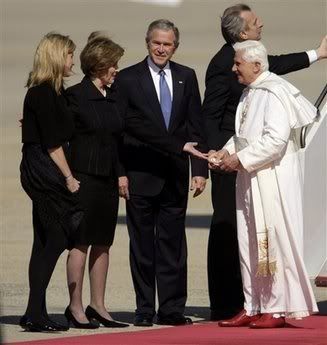
Another prayer from The Raccolta
Most holy Virgin and Mother, whose soul was pierced by a sword of sorrow in the Passion of thy Divine Son, and Who in His glorious Resurrection wast filled with never-ending joy at His triumph; obtain for us who call upon thee, so to be partakers in the adversities of Holy Church and the sorrows of the Sovereign Pontiff, as to be found worthy to rejoice with them in the consolations for which we pray, in the charity and peace of the same Christ our Lord.
Amen.
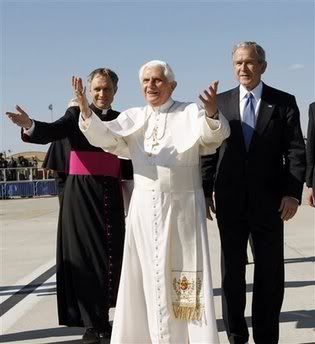
Lord Jesus, shelter our Holy Father the Pope under the protection of Thy Sacred Heart. Be Thou his light, his strength and his consolation.
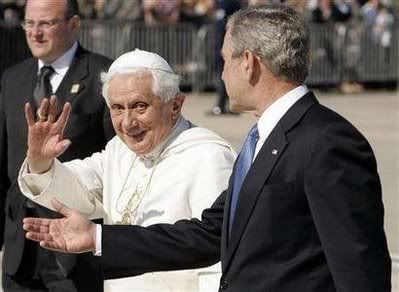
From Father Lovasik's Treasury Of Prayers
Jesus, Supreme Pontiff of the New and Eternal Testament, Thou art seated at the right hand of God as a perpetual Advocate for us and are pleased to be for all time with Thy beloved spouse the Church and with Thy vicar who governs her. Divine Prince of the pastors of Thy flock, You have deigned to place on the throne of Peter Thy servant and Pontiff, Pope Benedict Make him, in the midst of the wickedness of our times, mild in hostile attacks, strong in the defense of the faith, and a gentle father and watchful master in the pastoral office.
May Thy Kingdom come, Immortal King of the ages! May the truth, which Thou hast brought from Heaven, reach even to the ends of the earth. May the fire which Thou willest to be cast upon the earth inflame all hearts. This is the desire that is in the heart of Thy vicar: a desire to reconcile all men to Thee; a desire for concord and forgiveness among nations; a desire for justice and peace.
Jesus, enlighten Thy vicar. Strengthen him in his sorrows and in his universal cares. Speak that powerful word, O Lord, which shall change minds, turn hate into love, check the fury of human passions, temper the sufferings, and dry the tears of those who are in sorrow. Increase the virtue and the resignation of families and pacify nations and peoples so that the Church built by Thee on Saint Peter to gather all people around Thine altar of life and salvation, may invoke Thee, adore Thee, and exalt Thee in peace forever. Amen.
V. Let us pray for our Pontiff Benedict XVI
R. The Lord preserve him, and give him life, and bless him upon earth, and deliver him not up to the will of his enemies.
Our Father. Hail Mary.
O God, the Shepherd and Ruler of all Thy faithful people, mercifully look upon Thy servant N., whom Thou hast chosen as the chief Shepherd to preside over Thy Church. We beg Thee to help him edify, both by word and example, those over whom he has charge, that he may reach everlasting life together with the flock entrusted to him. Through Christ our Lord. Amen.
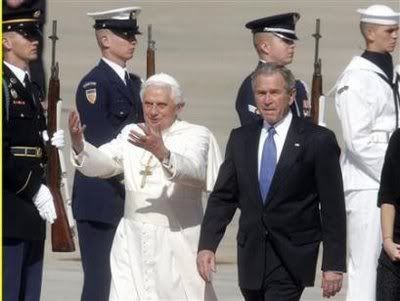
Chris Blosser is covering this visit better than I ever could.

Labels: Restorationists
Tuesday, April 15, 2008
Equal Time For Cousin Jonathan
Especially at this season of the year, as the anniversary of the Battles of Lexington and Concord approaches, I have been known to devote several photo-posts to the reenactors who portray the King's Forces of the American Revolution. Since I spent a very large portion of my life as one of them, it is perhaps natural that I would. People in the hobby have described being on the rebel side as getting one's undergraduate degree in American military history, but being on the British side to doctoral level work.
But of course this focus tends to neglect the dedicated folks on the other side of the battlefield, those who portray Massachusetts militia and the Continental Army. Many of these people have been donning the uniform since before the Bicentennial of the American Revolution (1975-1983). For them, no less than for their redcoated counterparts, "the hobby," as it is always called, is really a way of life, or a second career, something that absorbs at least 1-3 weekends every month during the temperate weather, and more.
The folks who play the rebels fall into two broad categories.
First, and most familiar to people in Greater Boston, are the local Minutemen and Militia Companies. These companies usually trace ancestry to the original town companies that served in the Battles of April 19, 1775. Most were created before the Bicentennial, sometimes as early as the Civil War Centennial (and this was all derivative of the commemorations of the Civil War's 100th birthday in the 1960s). They were often chartered by the local city or town. They are essentially local ceremonial units, that play a part in the locality's year-round life of luring tourism and marking military milestones like Veterans' Day, and Memorial Day, Flag Day and July 4th, along with any local anniversaries related to the town's role in the American Rebellion.
As they started out, most of them got caught up in the notion that they had to have a uniform appearance, which, of course, is completely inauthentic to the soldiers of 1775 they represent. Thus, the Lexington Minutemen always had a Continental Army uniform, of blue coats with buff facings (collar, cuffs, and lapels), made out of what appear to the naked eye to be polyester (which, of course, did not exist in 1775). Many other militia companies settled on uniform-colored and patterned waistcoats and breeches. Concord had buff. Wilmington, if memory serves, yellow.

Authenticity in these groups was, at the time of the Bicentennial, secondary to getting a big group together at an affordable price. You might see new members (and I have the photos to prove it) as late as the mid-1980s, in sneakers, knee breeches, and a fedora with a feather in it, with a puffy shirt and some modern vest. Facial hair, not warn by civilized Englishmen on either side of the Atlantic in 1775, flourished (this was the 1970s, remember). Modern eyeglasses would be worn, and hair would almost never be styled in the correct manner for 1775.
With the 225th anniversary in 2000, things began to change. Authenticity and faithful recreation of the Massachusetts citizen soldier of 1775 began to take on more importance, and was enforced by those organizing the important 225th anniversary events. They began to look more like the men who fought the King's troops on April 19th, 1775, and less like a raggle-taggle assortment of folks bound for a fancy dress party.
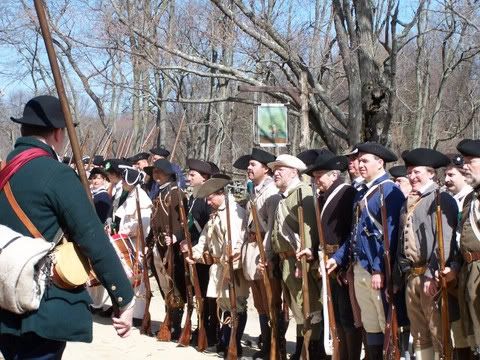
Groups that had always had two outfits, like the Lexington Minutemen, began to concentrate on the 1775 apparel more. Their appearance improved, and they became much more serious about training, tactics, and safety. They even changed thier name. They had been known as the Lexington Minutemen from time out of mind. But research showed that Lexington had not created a Minuteman Company before the battle of April 19th. In fact, the company that faced Major Pitcairn's six companies of British light infantry on the Green that fateful morning was known by its ancient name, the Training Band of the town of Lexington. The minutemen were an organization that some (most) towns had skimmed from the cream of their militia. But Lexington was not one of them. They had not organized minutemen in April, 1775. And as part of a new seriousness, the recreated Lexington militia became The Lexington Training Band.
I can recall when some militia companies were excluded from events because they not only sealed their black-powder-filled paper cartridges via a hot glue gun, but proceeded to stuff these objects down the musket barrel, and rammed them home, so that they were essentially shooting glue wads across the field, which is of course, very dangerous. That does not happen now.
Many nits that had only had a "ceremonial" uniform, began to move away from that, and began to take the field clad in what Massachusetts farmers of 1775 would have worn. Concord's militia is one of them. One almost never sees the buff waistcoats and breeches worn with the white puffy shirts anymore. Authentic appearance, training, and safety are the cornerstones of a re-birth of the Massachusetts militia of 1775 that has improved the hobby immensely.
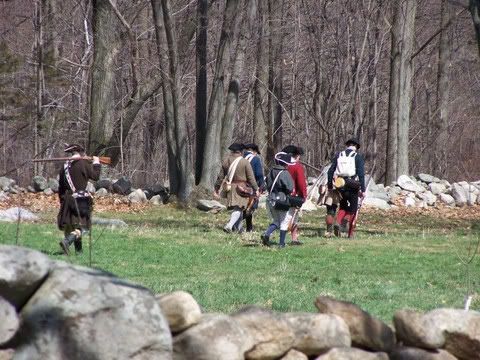
Of course there are units that will never be more than "marching and chowder societies." They cling to the old "uniforms" and the harem scarem disregard for safety and authenticity. But they can't take part in the big battles anymore, and that tends to force them to improve.
Way back when, I said that those on the American side fall into two categories. The other side of the equation is a furthering of the "professionalization" of the hobby. Beginning early in the Bicentennial, it was understood that to recreate the American soldier of that war, one would need Continental Army units, as well as minutemen and militia. These were the professional troops who did most of the soldiering and dying during the war. These are the guys who fought at Long Island, and Brandywine, at Saratoga, and at Monmouth, at Cowpens and Guilford Courthouse, and who watched O'Hara hand over Cornwallis' sword at Yorktown.
Continental Army units tend to be small, like their British counterparts. A company is usually 6-18 men. They wear uniforms, with a significant degree of variation within the ranks, unlike the redcoats, who strive for uniformity within a company. And in doing so, they are being authentic. When the British reenactors pack up the tents and drive to New York, New Jersey, Pennsylvania, or Virgina to fight a big weekend battle, these are the guys they fight. These are the guys they get drunk with at night, and the guys they meet at the sutlers' tents. I remember a few of my own men who became rebel hospitality casualties at events. Once I remember having to carry a guy who had enjoyed way too much rebel hospitality to his tent.
The 225th anniversary battles from 2000-2006 eventually changed the Continental Army units, too. Many, especially in the Northeast, while retaining their mid-late war uniforms, opted to spend the money for a second impression, that of militia. That way, they could participate in events like Battle Road 2000, the largest ever Rev War re-enactment in New England. They could not have gone as Continental Army units, since those did not exist in April, 1775. But by putting on proper 18th century civilian clothes, and varying the accoutrements normally worn somewhat, they could double as militia and appear in early war battles in authentic garb. And it should not be overlooked that these regulars taking on the role of militia had a leavening effect on the local minutemen and militia as well, raising the quality of the appearance of those units as well.

This is what a militia officer should look like.
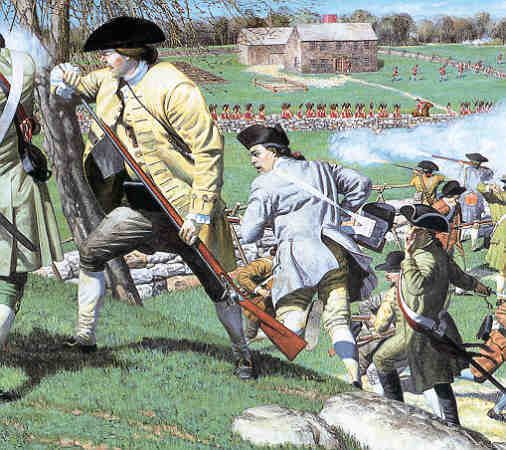
Muralist John Rush captured the authentic garb of the farmers of Eastern Massachusetts in 1775 for the National Park Service
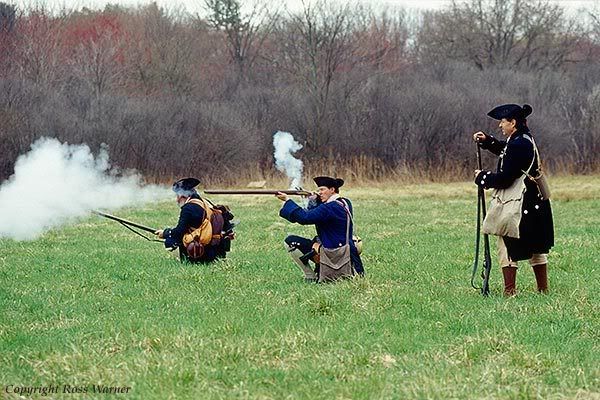
Much more authentic than everyone in a yellow waistcoat and breeches, and white shirt. April in Boston is much too cool for shirtsleeves.
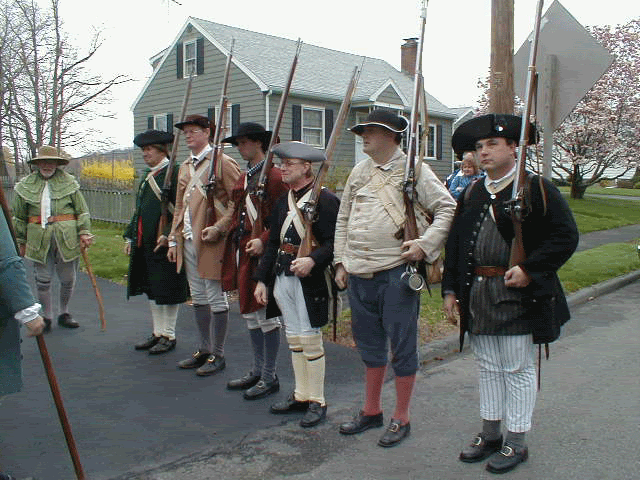
The Danvers Alarm List Company maintained a high level of authenticy even back in the Bicentennial.
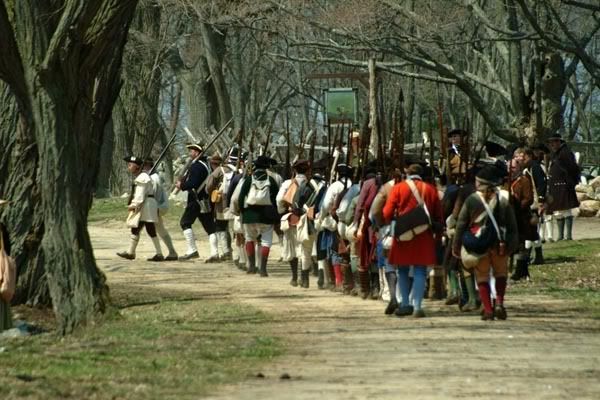

The Lexington Training Band on the Green, Patriots Day morning

More from Battle Road



Better training has allowed the rebels to cooperate as units

Winter Training, just like the original militia and minutemen

But as I said, while some units have made great strides towards authenticity, some will never be more than marching and chowder societies.
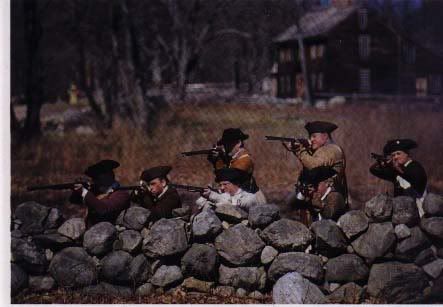
Rebel tactics have become closer to reality, too.
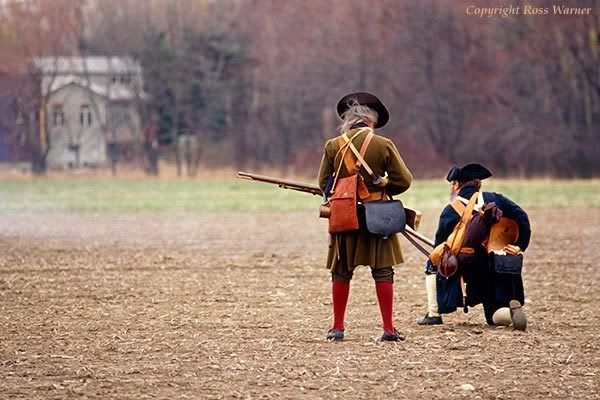
A last look at the rebel militia.
But of course this focus tends to neglect the dedicated folks on the other side of the battlefield, those who portray Massachusetts militia and the Continental Army. Many of these people have been donning the uniform since before the Bicentennial of the American Revolution (1975-1983). For them, no less than for their redcoated counterparts, "the hobby," as it is always called, is really a way of life, or a second career, something that absorbs at least 1-3 weekends every month during the temperate weather, and more.
The folks who play the rebels fall into two broad categories.
First, and most familiar to people in Greater Boston, are the local Minutemen and Militia Companies. These companies usually trace ancestry to the original town companies that served in the Battles of April 19, 1775. Most were created before the Bicentennial, sometimes as early as the Civil War Centennial (and this was all derivative of the commemorations of the Civil War's 100th birthday in the 1960s). They were often chartered by the local city or town. They are essentially local ceremonial units, that play a part in the locality's year-round life of luring tourism and marking military milestones like Veterans' Day, and Memorial Day, Flag Day and July 4th, along with any local anniversaries related to the town's role in the American Rebellion.
As they started out, most of them got caught up in the notion that they had to have a uniform appearance, which, of course, is completely inauthentic to the soldiers of 1775 they represent. Thus, the Lexington Minutemen always had a Continental Army uniform, of blue coats with buff facings (collar, cuffs, and lapels), made out of what appear to the naked eye to be polyester (which, of course, did not exist in 1775). Many other militia companies settled on uniform-colored and patterned waistcoats and breeches. Concord had buff. Wilmington, if memory serves, yellow.

Authenticity in these groups was, at the time of the Bicentennial, secondary to getting a big group together at an affordable price. You might see new members (and I have the photos to prove it) as late as the mid-1980s, in sneakers, knee breeches, and a fedora with a feather in it, with a puffy shirt and some modern vest. Facial hair, not warn by civilized Englishmen on either side of the Atlantic in 1775, flourished (this was the 1970s, remember). Modern eyeglasses would be worn, and hair would almost never be styled in the correct manner for 1775.
With the 225th anniversary in 2000, things began to change. Authenticity and faithful recreation of the Massachusetts citizen soldier of 1775 began to take on more importance, and was enforced by those organizing the important 225th anniversary events. They began to look more like the men who fought the King's troops on April 19th, 1775, and less like a raggle-taggle assortment of folks bound for a fancy dress party.

Groups that had always had two outfits, like the Lexington Minutemen, began to concentrate on the 1775 apparel more. Their appearance improved, and they became much more serious about training, tactics, and safety. They even changed thier name. They had been known as the Lexington Minutemen from time out of mind. But research showed that Lexington had not created a Minuteman Company before the battle of April 19th. In fact, the company that faced Major Pitcairn's six companies of British light infantry on the Green that fateful morning was known by its ancient name, the Training Band of the town of Lexington. The minutemen were an organization that some (most) towns had skimmed from the cream of their militia. But Lexington was not one of them. They had not organized minutemen in April, 1775. And as part of a new seriousness, the recreated Lexington militia became The Lexington Training Band.
I can recall when some militia companies were excluded from events because they not only sealed their black-powder-filled paper cartridges via a hot glue gun, but proceeded to stuff these objects down the musket barrel, and rammed them home, so that they were essentially shooting glue wads across the field, which is of course, very dangerous. That does not happen now.
Many nits that had only had a "ceremonial" uniform, began to move away from that, and began to take the field clad in what Massachusetts farmers of 1775 would have worn. Concord's militia is one of them. One almost never sees the buff waistcoats and breeches worn with the white puffy shirts anymore. Authentic appearance, training, and safety are the cornerstones of a re-birth of the Massachusetts militia of 1775 that has improved the hobby immensely.

Of course there are units that will never be more than "marching and chowder societies." They cling to the old "uniforms" and the harem scarem disregard for safety and authenticity. But they can't take part in the big battles anymore, and that tends to force them to improve.
Way back when, I said that those on the American side fall into two categories. The other side of the equation is a furthering of the "professionalization" of the hobby. Beginning early in the Bicentennial, it was understood that to recreate the American soldier of that war, one would need Continental Army units, as well as minutemen and militia. These were the professional troops who did most of the soldiering and dying during the war. These are the guys who fought at Long Island, and Brandywine, at Saratoga, and at Monmouth, at Cowpens and Guilford Courthouse, and who watched O'Hara hand over Cornwallis' sword at Yorktown.
Continental Army units tend to be small, like their British counterparts. A company is usually 6-18 men. They wear uniforms, with a significant degree of variation within the ranks, unlike the redcoats, who strive for uniformity within a company. And in doing so, they are being authentic. When the British reenactors pack up the tents and drive to New York, New Jersey, Pennsylvania, or Virgina to fight a big weekend battle, these are the guys they fight. These are the guys they get drunk with at night, and the guys they meet at the sutlers' tents. I remember a few of my own men who became rebel hospitality casualties at events. Once I remember having to carry a guy who had enjoyed way too much rebel hospitality to his tent.
The 225th anniversary battles from 2000-2006 eventually changed the Continental Army units, too. Many, especially in the Northeast, while retaining their mid-late war uniforms, opted to spend the money for a second impression, that of militia. That way, they could participate in events like Battle Road 2000, the largest ever Rev War re-enactment in New England. They could not have gone as Continental Army units, since those did not exist in April, 1775. But by putting on proper 18th century civilian clothes, and varying the accoutrements normally worn somewhat, they could double as militia and appear in early war battles in authentic garb. And it should not be overlooked that these regulars taking on the role of militia had a leavening effect on the local minutemen and militia as well, raising the quality of the appearance of those units as well.

This is what a militia officer should look like.

Muralist John Rush captured the authentic garb of the farmers of Eastern Massachusetts in 1775 for the National Park Service

Much more authentic than everyone in a yellow waistcoat and breeches, and white shirt. April in Boston is much too cool for shirtsleeves.

The Danvers Alarm List Company maintained a high level of authenticy even back in the Bicentennial.


The Lexington Training Band on the Green, Patriots Day morning

More from Battle Road



Better training has allowed the rebels to cooperate as units

Winter Training, just like the original militia and minutemen

But as I said, while some units have made great strides towards authenticity, some will never be more than marching and chowder societies.

Rebel tactics have become closer to reality, too.

A last look at the rebel militia.
Labels: Once A Redcoat


